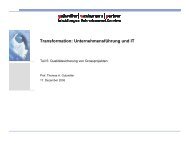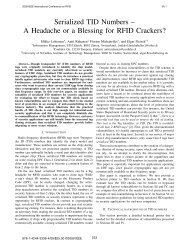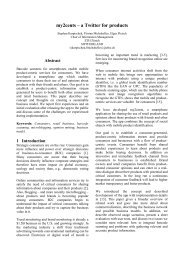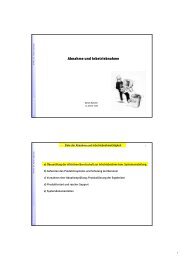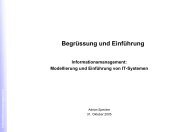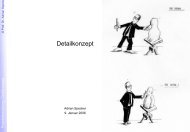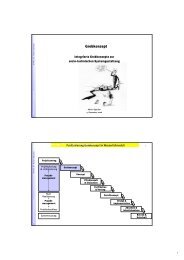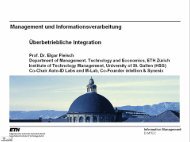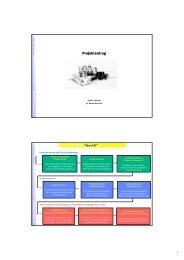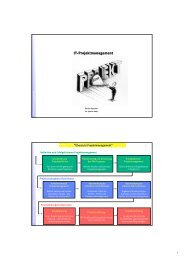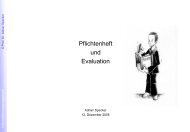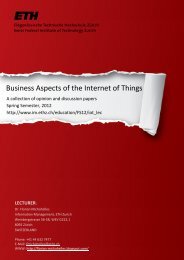4 The Toolkit Approach for End-User Participation in ... - ETH Zürich
4 The Toolkit Approach for End-User Participation in ... - ETH Zürich
4 The Toolkit Approach for End-User Participation in ... - ETH Zürich
You also want an ePaper? Increase the reach of your titles
YUMPU automatically turns print PDFs into web optimized ePapers that Google loves.
4 <strong>The</strong> <strong>Toolkit</strong> <strong>Approach</strong> <strong>for</strong> <strong>End</strong>-<strong>User</strong><br />
<strong>Participation</strong> <strong>in</strong> the Internet of Th<strong>in</strong>gs<br />
Irena Pletikosa Cvijikj and Florian Michahelles<br />
In<strong>for</strong>mation Management, Department of Management, Technology and Economics, <strong>ETH</strong><br />
<strong>Zürich</strong>, Switzerland<br />
{ipletikosa, fmichahelles}@ethz.ch<br />
Abstract Today, there are many end-user programm<strong>in</strong>g tools available, but <strong>in</strong><br />
the Internet of Th<strong>in</strong>gs doma<strong>in</strong>, this concept is relatively new. Some pioneer examples<br />
<strong>in</strong>clude solutions, such as d.tools and Pachube, but also Web2.0, Mash-ups,<br />
Twitter and Facebook are suitable backplanes <strong>for</strong> this k<strong>in</strong>d of applications. Another<br />
level of development support is various hardware concepts and solutions, such<br />
as RFIDs, Ardu<strong>in</strong>o, Violet, NFC, barcodes and many more. Appropriate user programmability<br />
could trans<strong>for</strong>m a system, multiply<strong>in</strong>g the effectiveness of programmers<br />
and users. This article discusses how end-users can be empowered with<br />
new build<strong>in</strong>g blocks and tools, analogous to those that were emerg<strong>in</strong>g dur<strong>in</strong>g the<br />
early phases of Internet growth. Accelerators, frameworks and toolkits are <strong>in</strong>troduced,<br />
which would allow everybody to participate <strong>in</strong> the Internet of Th<strong>in</strong>gs <strong>in</strong> the<br />
same manner as <strong>in</strong> the Internet through Wikis, Blogs etc.<br />
4.1 From Internet to Internet of Th<strong>in</strong>gs<br />
Back <strong>in</strong> the 1960s, a group of visionaries saw great potential <strong>in</strong> allow<strong>in</strong>g computers<br />
to share <strong>in</strong><strong>for</strong>mation, which contributed to the creation of what is today known<br />
as Internet. <strong>The</strong> first network, ARPANET, was developed <strong>for</strong> a very special purpose:<br />
the connection of just four major computers at universities <strong>in</strong> southwestern<br />
US (Salus 1995). This early <strong>for</strong>m of Internet was founded by the government and<br />
was used only by computer experts, scientists and librarians <strong>for</strong> research, education,<br />
military and government purposes. <strong>The</strong>re were no personal computers and<br />
anyone who used it, had to learn how to use a very complex system. Commercial<br />
uses were prohibited unless they directly served the goals of research and education.<br />
This policy cont<strong>in</strong>ued until the late 80's, when the major breakthrough came<br />
with the <strong>in</strong>troduction of Berners-Lee's World Wide Web. <strong>The</strong> new protocol he<br />
proposed gave simple <strong>in</strong><strong>for</strong>mation access to the general public by embedd<strong>in</strong>g<br />
hypertext <strong>in</strong>to the Internet. In the follow<strong>in</strong>g years, the lower<strong>in</strong>g of barriers has
2<br />
made it simple enough, not just to use the Internet, but also to shape it and to add<br />
and generate new services. <strong>The</strong> second generation of the Internet, called Web 2.0<br />
or social web, with its key support<strong>in</strong>g technologies, Ajax, Wiki, Blog, RSS, and<br />
Atom became ubiquitous, faster, and <strong>in</strong>creas<strong>in</strong>gly accessible to non-technical<br />
communities, thus <strong>in</strong>troduc<strong>in</strong>g the rapid content generation and distribution, which<br />
lead to the richness of <strong>in</strong><strong>for</strong>mation of today’s Internet.<br />
It is evident that from its beg<strong>in</strong>n<strong>in</strong>g the Internet was chang<strong>in</strong>g very fast and<br />
nowadays it is still evolv<strong>in</strong>g. However, <strong>in</strong>stead of just connect<strong>in</strong>g computers<br />
and/or wearable devices, it grew from a network l<strong>in</strong>k<strong>in</strong>g digital <strong>in</strong><strong>for</strong>mation to a<br />
network relat<strong>in</strong>g digital <strong>in</strong><strong>for</strong>mation to real world physical items. This new network<br />
is called Internet of Th<strong>in</strong>gs (IOT) and provides embedd<strong>in</strong>g of physical reality<br />
<strong>in</strong>to the Internet and <strong>in</strong><strong>for</strong>mation <strong>in</strong>to the physical reality.<br />
<strong>The</strong> concept of IOT became popular <strong>in</strong> 1999, when the Auto-ID Center at Massachusetts<br />
Institute of Technology (MIT) designed the RFID technology. Kev<strong>in</strong><br />
Ashton, co-founder and director of MIT, <strong>in</strong> an article published <strong>in</strong> Forbes Magaz<strong>in</strong>e,<br />
<strong>in</strong> 2002, said,<br />
“...we need an <strong>in</strong>ternet <strong>for</strong> th<strong>in</strong>gs, a standardized way <strong>for</strong> computers to understand the real<br />
world...”<br />
<strong>The</strong> name of this article conta<strong>in</strong>ed the first documented usage of the term Internet<br />
of Th<strong>in</strong>gs <strong>in</strong> literature. In the follow<strong>in</strong>g years this idea became more popular<br />
(Friedemann and Flörkemeier 2009) and <strong>in</strong> 2009 it was recognized as a general<br />
trans<strong>for</strong>mation of the Internet by the EU Commission (European Commission<br />
2009).<br />
Smart objects play the central role <strong>in</strong> the Internet of Th<strong>in</strong>gs idea. Equipped with<br />
<strong>in</strong><strong>for</strong>mation and communication technology, everyday items provide a new quality<br />
by featur<strong>in</strong>g t<strong>in</strong>y computers. <strong>The</strong>se objects can store their context, they are networked<br />
together, they are able to access Internet services and they <strong>in</strong>teract among<br />
themselves and with human be<strong>in</strong>gs. In order to connect everyday objects and devices<br />
to large databases and networks, a simple, unobtrusive and cost-effective<br />
system of item identification is required. Radio-frequency identification (RFID)<br />
offers this functionality.<br />
Based on this concept, many traditional <strong>in</strong>dustries, such as logistics, manufactur<strong>in</strong>g<br />
and retail, have <strong>in</strong>creased their effectiveness of the production cycle by implement<strong>in</strong>g<br />
smart devices through RFID and barcode technologies. <strong>The</strong> cost of rudimentary<br />
RFID tags promises to drop to roughly $0.05/unit <strong>in</strong> the next several<br />
years (Sarma 2001), while tags as small as 0.4mm × 0.4mm, and th<strong>in</strong> enough to be<br />
embedded <strong>in</strong> paper are already commercially available (Takaragi et al. 2001).<br />
Such improvements <strong>in</strong> cost and size will lead to a second wave of applications <strong>in</strong>clud<strong>in</strong>g<br />
vertical market applications, ubiquitous position<strong>in</strong>g and physical world<br />
web, i.e. the real Internet of Th<strong>in</strong>gs. However, at the moment the Internet of<br />
Th<strong>in</strong>gs is still mostly governed by bus<strong>in</strong>ess applications.<br />
On the other hand, new generations of smart phones, sensor networks, opensource<br />
Application Programm<strong>in</strong>g Interfaces (APIs) and toolkits are becom<strong>in</strong>g<br />
more and more pervasive. Still, these devices are mostly not customized to meet
specific user expectations. Emerg<strong>in</strong>g trends of user programm<strong>in</strong>g (Scaffidi et al.<br />
2005) give the opportunity to non-professional end-users of mak<strong>in</strong>g additions to<br />
products, accord<strong>in</strong>g to their specific needs. However, to let <strong>in</strong>dividuals play a<br />
ma<strong>in</strong> role <strong>in</strong> the Internet of Th<strong>in</strong>gs, there are still a number of problems and challenges<br />
to overcome.<br />
4.2 Problems and Challenges<br />
<strong>The</strong> development of tools and techniques is a key focus <strong>for</strong> the concept of participatory<br />
design (PD). <strong>End</strong>-user tools and techniques should promote a practice<br />
where researchers and design professionals will be able to learn about users’ work,<br />
and where users will be able to take an active part <strong>in</strong> technology design. To<br />
achieve this, these tools should avoid traditional design techniques with abstract<br />
representations, and <strong>in</strong>stead allow users to more easily experiment with various<br />
design possibilities <strong>in</strong> a cost effective way (Kens<strong>in</strong>g and Blomberg 1998).<br />
Gronbaek et al. (1997) suggest the use of cooperative prototyp<strong>in</strong>g, where users<br />
and designers collectively explore the functionality and <strong>for</strong>m of applications as<br />
well as their relations to the work <strong>in</strong> question. This type of cooperation requires<br />
access to adequate prototyp<strong>in</strong>g tools, which would act as catalysts and triggers <strong>in</strong><br />
discussions about the relations between work and technology (Mogensen 1992),<br />
(Trigg et al. 1991). Tools and techniques used <strong>in</strong> PD projects should all have the<br />
common aim of provid<strong>in</strong>g designers and users with a way of connect<strong>in</strong>g current<br />
and future work practices with envisioned new technologies.<br />
Despite all the challenges, the need <strong>for</strong> <strong>in</strong>novation has been recognized and<br />
supported. S<strong>in</strong>ce IOT systems will be designed, managed and used by multiple<br />
stakeholders, driven by different bus<strong>in</strong>ess models and various <strong>in</strong>terests, these systems<br />
should (European Commission 2009):<br />
� allow new applications to be built on top of exist<strong>in</strong>g systems,<br />
� allow new systems to be deployed <strong>in</strong> parallel with exist<strong>in</strong>g systems, and<br />
� allow an adequate level of <strong>in</strong>teroperability, so that <strong>in</strong>novative and competitive<br />
cross-doma<strong>in</strong> systems and applications can be developed.<br />
Pioneer projects <strong>in</strong> this field, some of which are presented later <strong>in</strong> this chapter,<br />
have already been developed. Still, real-case user-driven scenarios do not exist<br />
yet, lead<strong>in</strong>g to a situation where the uptake of the technology itself is slowed<br />
down. To overcome this situation, end-users must be empowered with new build<strong>in</strong>g<br />
blocks and tools that were analogously emerg<strong>in</strong>g dur<strong>in</strong>g the Internet growth.<br />
3
4<br />
4.3 Towards a Participatory <strong>Approach</strong><br />
<strong>The</strong> process of design<strong>in</strong>g and develop<strong>in</strong>g new solutions presents a big challenge<br />
<strong>for</strong> scientists and manufacturers, even when it is about simple, everyday objects.<br />
When design<strong>in</strong>g a new product, solutions are usually based on observations and<br />
usability conclusions. However, once the product has left the laboratory, the situation<br />
is completely different. <strong>The</strong> problem lies <strong>in</strong> the fact that designers are often<br />
drawn <strong>in</strong>to the trap of try<strong>in</strong>g to f<strong>in</strong>d uses <strong>for</strong> the tools, and deploy<strong>in</strong>g the coolest<br />
new features, <strong>for</strong>gett<strong>in</strong>g their primary focus should be on provid<strong>in</strong>g value to the<br />
end user. However, the large variety of end users, usage conditions and scenarios<br />
usually leads to confusion and dissatisfaction regard<strong>in</strong>g the usability of the product<br />
<strong>in</strong> the real world environment.<br />
<strong>The</strong> concept of personalization offers the solution <strong>for</strong> the described situation.<br />
Still, a designer work<strong>in</strong>g on a task of personalization on an exist<strong>in</strong>g application, or<br />
build<strong>in</strong>g a new personalized application, is poised to make the classic error of<br />
putt<strong>in</strong>g technology be<strong>for</strong>e the needs of the end users (Kramer et al. 2000). Based<br />
on these observations, a new idea has grown, focus<strong>in</strong>g on <strong>in</strong>volv<strong>in</strong>g end users <strong>in</strong>to<br />
the development process.<br />
4.3.1 <strong>User</strong>-Centered Design<br />
<strong>User</strong>-centered design (UCD) is a broad term, used to describe a design philosophy<br />
and a variety of methods <strong>in</strong> which the needs, wants, and limitations of end users<br />
are placed at the center of attention at each stage of the design process. UCD differs<br />
from other approaches <strong>in</strong> try<strong>in</strong>g to optimize the solutions based on how<br />
people can, want or need to use them, rather than <strong>for</strong>c<strong>in</strong>g the users to change their<br />
work<strong>in</strong>g habits <strong>in</strong> order to comply with the offered approach. UCD is based on <strong>in</strong>volv<strong>in</strong>g<br />
the users <strong>in</strong> different stages of the design process, from gather<strong>in</strong>g ideas <strong>for</strong><br />
functional requirements and usability test<strong>in</strong>g, to direct <strong>in</strong>volvement <strong>in</strong>to the development<br />
process itself.<br />
<strong>The</strong> term ‘user-centered design’ was <strong>in</strong>itially used by Donald Norman from the<br />
University of Cali<strong>for</strong>nia San Diego (UCSD) <strong>in</strong> the 1980s and became widely used<br />
after the publication of his co-authored book “<strong>User</strong>-Centered System Design: New<br />
Perspectives on Human-Computer Interaction” (Norman and Draper 1986). Norman's<br />
work expla<strong>in</strong>ed that <strong>in</strong>volv<strong>in</strong>g actual users <strong>in</strong> the development process, preferably<br />
<strong>in</strong> the environment <strong>in</strong> which the product would be used, was a natural evolution<br />
<strong>in</strong> the field of user centered design. Based on these statements, users<br />
became a central part of the development process result<strong>in</strong>g <strong>in</strong> more effective, efficient<br />
and safer products (Abras et al. 2004).
4.3.1.1 <strong>User</strong>-Centered Pr<strong>in</strong>ciples and Activities<br />
Today, there is an <strong>in</strong>ternational standard, ISO 13407: Human-centered design<br />
process (ISO 13407 1999), that def<strong>in</strong>es a general process <strong>for</strong> <strong>in</strong>clud<strong>in</strong>g humancentered<br />
activities throughout a development life-cycle. This standard describes<br />
four pr<strong>in</strong>ciples of user-centered design:<br />
� active <strong>in</strong>volvement of users,<br />
� appropriate allocation of function to system and to user,<br />
� iteration of design solutions, and<br />
� multi-discipl<strong>in</strong>ary design;<br />
and four user-centered design activities:<br />
� requirements gather<strong>in</strong>g, understand<strong>in</strong>g and specify<strong>in</strong>g the context of use;<br />
� requirements specification, specify<strong>in</strong>g the user and organizational requirements;<br />
� design, produc<strong>in</strong>g designs and prototypes; and<br />
� evaluation, carry<strong>in</strong>g out user-based assessment of the site.<br />
<strong>The</strong> process <strong>in</strong>volves iterat<strong>in</strong>g through these activities until the objectives are satisfied.<br />
As a <strong>for</strong>m of UDC per<strong>for</strong>med dur<strong>in</strong>g the design activity, participatory design,<br />
focus<strong>in</strong>g on the participation of users <strong>in</strong> the development process, has ga<strong>in</strong>ed<br />
strong acceptance, particularly <strong>in</strong> Scand<strong>in</strong>avian countries.<br />
4.3.1.2 Participatory Design<br />
Participatory design (PD) applications are diverse <strong>in</strong> their perspectives, backgrounds,<br />
and areas of concern, lead<strong>in</strong>g to a lack of a s<strong>in</strong>gle def<strong>in</strong>ition. However, <strong>in</strong><br />
its essence, participatory design represents an approach towards assessment, design<br />
and development of various systems <strong>in</strong> which people, dest<strong>in</strong>ed to actually use<br />
these systems, play the major role <strong>in</strong> design<strong>in</strong>g and <strong>in</strong> the decision-mak<strong>in</strong>g<br />
process. In other words, users are the co-designers of the systems.<br />
<strong>The</strong> participatory design approach emerged <strong>in</strong> the mid 1970s <strong>in</strong> Scand<strong>in</strong>avia,<br />
under the name cooperative design. It was born out of the labor union’s push <strong>for</strong><br />
workers to have more democratic control <strong>in</strong> their work environment (Ehn 1989).<br />
However, when presented to the US community, due to the strong separation between<br />
managers and workers, participatory was the more appropriate description<br />
of the process, where managers and workers did not sit and work together, but rather<br />
work separately on the same problems, thus participat<strong>in</strong>g <strong>in</strong> the solution f<strong>in</strong>d<strong>in</strong>g<br />
process. Pioneer projects <strong>in</strong>cluded:<br />
� Norwegian Iron and Metal Workers Union (NJMF) project, that took a first<br />
move from traditional research to work<strong>in</strong>g with people (Ehn and Kyng 1987),<br />
5
6<br />
� Utopia project (Bodker et al. 1987), (Ehn 1988), whose major achievements<br />
were the experience-based design methods, developed through the focus on<br />
hands-on experiences, emphasiz<strong>in</strong>g the need <strong>for</strong> technical and organizational<br />
alternatives, and<br />
� Florence project (Bjerknes and Bratteteig 1995) which has started a long l<strong>in</strong>e of<br />
Scand<strong>in</strong>avian research projects <strong>in</strong> the health sector, giv<strong>in</strong>g voice to nurses dur<strong>in</strong>g<br />
the development of work and IT <strong>in</strong> hospitals.<br />
S<strong>in</strong>ce then, participatory design projects have varied with respect to how and why<br />
workers have participated, from be<strong>in</strong>g limited to provid<strong>in</strong>g designers with access<br />
to workers’ skills and experiences, where workers have little or no control over the<br />
design process or its outcome, to fully participat<strong>in</strong>g <strong>in</strong> the process. In all cases,<br />
worker participation is considered central to the value and, there<strong>for</strong>e, the success<br />
of the project (Kens<strong>in</strong>g and Blomberg 1998).<br />
Caused by the differences that can arise between users and designers, sometimes<br />
the users are unable to understand the language of the designers. <strong>The</strong>re<strong>for</strong>e,<br />
the development of <strong>in</strong>novative tools and techniques is a key focus <strong>for</strong> PD projects<br />
and their extension <strong>in</strong>to the specific context of particular projects has become part<br />
of PD researchers’ repertoire <strong>for</strong> action. PD techniques <strong>in</strong>volve <strong>in</strong><strong>for</strong>mal presentation<br />
of relations between technology and work, <strong>in</strong>clud<strong>in</strong>g visualizations (Brun-<br />
Cottan and Wall 1995), toolkits, prototypes and mockups. <strong>The</strong>se tools and techniques<br />
promote a practice where both, the technology and the work organization<br />
are <strong>in</strong> focus, and where users are able to take an active part <strong>in</strong> technology design.<br />
At the dawn of the 21st century, technology is an <strong>in</strong>separable part of everyday<br />
life, used at work, at home, <strong>in</strong> school, and on the move. This poses a new challenge<br />
to participatory design to embrace the fact that much technology development<br />
no longer happens as a design of isolated systems <strong>in</strong> well-def<strong>in</strong>ed work<strong>in</strong>g<br />
environments (Beck 2002), but <strong>in</strong>stead community based development is becom<strong>in</strong>g<br />
an emerg<strong>in</strong>g trend. This produces new techniques <strong>in</strong> development processes,<br />
such as open-source development, end-user programm<strong>in</strong>g, crowd sourc<strong>in</strong>g and<br />
others, discussed below.<br />
4.3.2 Open-Source Development<br />
Open source (OS) is a development method <strong>for</strong> software that harnesses the power<br />
of distributed peer review and transparency of process. <strong>The</strong> promise of open<br />
source is software or products of better quality, higher reliability, more flexibility,<br />
lower cost, and an end to predatory vendor lock-<strong>in</strong> (Open Source Initiative).<br />
<strong>The</strong> concept of free software is an old one and can be traced back to the 1950s.<br />
First computers served only as research tools at universities, software was exchanged<br />
freely and programmers were paid <strong>for</strong> the programm<strong>in</strong>g as a process, and<br />
not <strong>for</strong> the software itself. When computers reached the bus<strong>in</strong>ess world, software
ecame commercialized and developers started charg<strong>in</strong>g <strong>for</strong> each <strong>in</strong>stallation<br />
copy. In 1984, Richard Stallmann, a researcher at MIT, founded the Free Software<br />
Foundation (FSF) and the GNU project (GNU manifesto), thus provid<strong>in</strong>g the<br />
foundations <strong>for</strong> today's open source movement. Where proprietary commercial<br />
software vendors saw an economic opportunity that must be protected, Stallman<br />
saw scientific knowledge that must be shared and distributed (Dibona et al. 1999).<br />
<strong>The</strong> open source software movement has received enormous attention <strong>in</strong> the last<br />
several years. It is often characterized as a fundamentally new way to develop<br />
software (Raymond 1999) that poses a serious challenge (Dibona et al. 1999) to<br />
the commercial software bus<strong>in</strong>esses, which dom<strong>in</strong>ate most software markets today<br />
(Mockus et al. 2002). Accord<strong>in</strong>g to SourceForge.net, as of August, 2010, more<br />
than 240,000 software projects have been registered to use their services by more<br />
than 2.6 million registered users.<br />
<strong>The</strong> open source development model fundamentally differs from the approaches<br />
and economics of traditional software development. First, the usual goal of an<br />
open source project is to create a system that is useful or <strong>in</strong>terest<strong>in</strong>g to those who<br />
are work<strong>in</strong>g on it (Godfrey and Tu 2000). Many successful “open source” software<br />
products have been and are be<strong>in</strong>g developed, distributed, and supported by<br />
an <strong>in</strong>ternet-based community of programmers, i.e. users themselves (Lakhani and<br />
von Hippel 2003). Developers are often unpaid volunteers who contribute towards<br />
the project as a hobby and there is no direct compensation <strong>for</strong> their work (Hars<br />
and Ou 2002). <strong>The</strong> question that this poses is the motivation <strong>for</strong> open-source development?<br />
Eric Raymond reports (Raymond 1999) that there are at least three basic<br />
motives <strong>for</strong> writ<strong>in</strong>g or contribut<strong>in</strong>g to the open source projects: user’s direct<br />
need <strong>for</strong> the software and software improvements, enjoyment of the work itself<br />
and the enhanced reputation.<br />
<strong>The</strong> most fasc<strong>in</strong>at<strong>in</strong>g development <strong>in</strong> the open source movement today is not<br />
necessarily the success of companies like Red Hat or Sendmail Inc. Instead, see<strong>in</strong>g<br />
major corporations like IBM and Oracle, turn<strong>in</strong>g their attention to Open Source as<br />
a bus<strong>in</strong>ess opportunity is <strong>in</strong>trigu<strong>in</strong>g. <strong>The</strong>re is only one explanation <strong>for</strong> this behavior:<br />
<strong>in</strong>novation (Dibona et al. 1999). <strong>The</strong> new concept based on this, also known<br />
as open <strong>in</strong>novation, is us<strong>in</strong>g the open source as the most natural network <strong>for</strong> <strong>in</strong>novations<br />
(von Hippel 2002).<br />
4.3.3 <strong>End</strong>-<strong>User</strong> Programm<strong>in</strong>g<br />
A further type of community-based development is end-user programm<strong>in</strong>g. One<br />
way to def<strong>in</strong>e programm<strong>in</strong>g is as the process of trans<strong>for</strong>m<strong>in</strong>g a mental plan of desired<br />
actions <strong>for</strong> a computer <strong>in</strong>to a representation that can be understood by the<br />
computer (Hoc and Nguyen-Xuan 1990). Back <strong>in</strong> the 1940s, at the beg<strong>in</strong>n<strong>in</strong>g of<br />
the era of computers, programm<strong>in</strong>g was done only by a small number of scientists,<br />
i.e. professional software developers. S<strong>in</strong>ce that time, software <strong>in</strong>dustry has been<br />
grow<strong>in</strong>g rapidly, and computer programm<strong>in</strong>g has become a technical skill of mil-<br />
7
8<br />
lions. In parallel, a second, powerful trend has begun to take shape, the so-called<br />
end-user programm<strong>in</strong>g (Myers and Ko 2009).<br />
To understand the concept of end-user programm<strong>in</strong>g, it is important to expla<strong>in</strong><br />
the difference between professional and end-user programmers. While professional<br />
programmers develop software as a part of their jobs, end-user programmers are<br />
people who also write programs, but not as their primary job function. <strong>The</strong>y are<br />
not <strong>for</strong>mally tra<strong>in</strong>ed <strong>in</strong> programm<strong>in</strong>g, yet need to program <strong>in</strong> order to accomplish<br />
their daily tasks. Spreadsheets are considered the major success story <strong>in</strong> end-user<br />
programm<strong>in</strong>g (Erwig 2009); however, many end-user programmers also use other<br />
special-purpose languages, or are even faced with the requirement of learn<strong>in</strong>g professional<br />
programm<strong>in</strong>g languages to achieve their goals. Despite the differences <strong>in</strong><br />
priorities between professionals and end-user programmers, they both face the<br />
same software eng<strong>in</strong>eer<strong>in</strong>g challenges.<br />
<strong>End</strong>-user programm<strong>in</strong>g has become so ubiquitous, that today there are more<br />
end-user programmers than there are professional programmers. Accord<strong>in</strong>g to the<br />
expert estimations (Scaffidi et al. 2005), <strong>in</strong> 2012, 90 million Americans will use<br />
computers on workplaces, significantly exceed<strong>in</strong>g the 3 million anticipated professional<br />
programmers. Over 13 million workers will “do programm<strong>in</strong>g” <strong>in</strong> a selfreport<strong>in</strong>g<br />
sense; and more than 55 million people will use spreadsheets and databases.<br />
Due to the variety of end-user programmer profiles and backgrounds, there is<br />
not a s<strong>in</strong>gle method <strong>for</strong> end-user programm<strong>in</strong>g. Instead, several techniques are be<strong>in</strong>g<br />
used, <strong>in</strong>clud<strong>in</strong>g programm<strong>in</strong>g by demonstration, visual and natural programm<strong>in</strong>g<br />
and many doma<strong>in</strong>-specific languages and <strong>for</strong>malisms (<strong>End</strong>-<strong>User</strong> Programm<strong>in</strong>g).<br />
What are the benefits of this approach? <strong>The</strong> obvious and most important one is:<br />
users know their problems best. <strong>The</strong>re<strong>for</strong>e, software products could become simpler,<br />
and at the same time more reliable. Only the general features will be supported<br />
by the issu<strong>in</strong>g company, while details will be developed by end-user programmers,<br />
thus provid<strong>in</strong>g a richness of features that would otherwise be difficult to expla<strong>in</strong><br />
to a programmer. Allow<strong>in</strong>g users to add their programs would give them<br />
freedom and responsibility at the same time. <strong>The</strong>re<strong>for</strong>e, it is beneficial <strong>for</strong> both users<br />
and product developers, to use these techniques and provide end-users with the<br />
possibility to shape products accord<strong>in</strong>g to their needs.<br />
4.3.4 Crowdsourc<strong>in</strong>g<br />
“<strong>The</strong>re is an <strong>in</strong>credible story to be told about human <strong>in</strong>genuity! <strong>The</strong> first step to its<br />
unfold<strong>in</strong>g is to reject the b<strong>in</strong>ary notion of client/designer. ... <strong>The</strong> old-fashioned notion of<br />
an <strong>in</strong>dividual with a dream of perfection is be<strong>in</strong>g replaced by distributed problem solv<strong>in</strong>g<br />
and team-based multi-discipl<strong>in</strong>ary practice. <strong>The</strong> reality <strong>for</strong> advanced design today is<br />
dom<strong>in</strong>ated by three ideas: distributed, plural, collaborative. … Problems are taken up<br />
everywhere, solutions are developed and tested and contributed to the global commons,
and those ideas are tested aga<strong>in</strong>st other solutions. <strong>The</strong> effect of this is to imag<strong>in</strong>e a future<br />
<strong>for</strong> design that is both more modest and more ambitious.” (Mau 2004)<br />
<strong>The</strong> term crowdsourc<strong>in</strong>g was <strong>in</strong>itially used by Jeff Howe and Mark Rob<strong>in</strong>son <strong>in</strong><br />
2006 <strong>for</strong> describ<strong>in</strong>g a new web-based, distributed problem-solv<strong>in</strong>g and production<br />
model that has emerged <strong>in</strong> recent years. Howe offers the follow<strong>in</strong>g def<strong>in</strong>ition:<br />
“Crowdsourc<strong>in</strong>g is the act of tak<strong>in</strong>g a job traditionally per<strong>for</strong>med by a designated agent<br />
(usually an employee) and outsourc<strong>in</strong>g it to an undef<strong>in</strong>ed, generally large group of people<br />
<strong>in</strong> the <strong>for</strong>m of an open call.” (Crowdsourc<strong>in</strong>g)<br />
In other words, crowdsourc<strong>in</strong>g is a process engag<strong>in</strong>g the follow<strong>in</strong>g major steps, (1)<br />
company posts a problem onl<strong>in</strong>e, (2) a vast number of <strong>in</strong>dividuals offer solutions,<br />
(3) w<strong>in</strong>n<strong>in</strong>g ideas are selected and awarded (Wikipedia). <strong>The</strong> difference between<br />
crowdsourc<strong>in</strong>g and ord<strong>in</strong>ary outsourc<strong>in</strong>g is that a task or problem is outsourced to<br />
an undef<strong>in</strong>ed public rather than a specific other body. On the other hand, crowdsourc<strong>in</strong>g<br />
differs from the open-source practice. Problems solved and products designed<br />
by the crowd become the property of companies, who turn large profits off<br />
from this crowd labor. Technological advances are break<strong>in</strong>g down the cost barriers<br />
that once separated amateurs from professionals. New markets <strong>for</strong> the ef<strong>for</strong>ts of<br />
non-professionals open, as smart companies discover ways to tap the latent talent<br />
of the crowd. <strong>The</strong> labor isn’t always free, but it costs a lot less than pay<strong>in</strong>g traditional<br />
employees (Howe 2006).<br />
Crowdsourc<strong>in</strong>g plat<strong>for</strong>ms appear to be a good place <strong>for</strong> young professionals or<br />
amateur affirmation. Learn<strong>in</strong>g, resource exchanges, comparison, recognition by<br />
peers or by companies, capitalization of proposals and successes rema<strong>in</strong> the ma<strong>in</strong><br />
stimulation <strong>for</strong> creation, even if participants have a low chance of earn<strong>in</strong>g f<strong>in</strong>ancial<br />
rewards (Trompette et al. 2008). Based on the pr<strong>in</strong>ciple of open<strong>in</strong>g the design/development<br />
process to the crowd, <strong>in</strong>itiated either by the company or the<br />
community, crowdsourc<strong>in</strong>g provides the way to access external knowledge <strong>for</strong> the<br />
purposes of <strong>in</strong>novation, thus comply<strong>in</strong>g with the pr<strong>in</strong>ciples of open <strong>in</strong>novations.<br />
4.3.5 Liv<strong>in</strong>g Labs<br />
Although the majority considers that the concept of Liv<strong>in</strong>g Lab orig<strong>in</strong>ates from<br />
William Mitchell, professor at MIT, Boston, it seems that the term Liv<strong>in</strong>g Laboratory<br />
was <strong>in</strong>itially used <strong>in</strong> literature by Abowd and his colleagues at Georgia Institute<br />
of Technology to refer to real-world contexts, <strong>in</strong> which users were given the<br />
opportunity to European state-of-the art technology (Abowd 1999). <strong>The</strong> concept<br />
was based on the idea of smart/future homes, serv<strong>in</strong>g as "real home" sett<strong>in</strong>gs<br />
where real people were observed <strong>in</strong> their usage of emerg<strong>in</strong>g technologies. Markopoulos<br />
and Rauterberg gave broader def<strong>in</strong>ition by envision<strong>in</strong>g the liv<strong>in</strong>g lab as<br />
"... a planned research <strong>in</strong>frastructure that is pivotal <strong>for</strong> user-system <strong>in</strong>teraction research <strong>in</strong><br />
the next decade" (Markopoulos and Rauterberg 2000).<br />
9
10<br />
<strong>The</strong>y have described the Liv<strong>in</strong>g Labs as plat<strong>for</strong>ms <strong>for</strong> collaborative research that<br />
will serve as a basis <strong>for</strong> development and test<strong>in</strong>g of novel technologies.<br />
Today, the literature dist<strong>in</strong>guishes between two different <strong>in</strong>terpretations of the<br />
Liv<strong>in</strong>g Labs concept (Folstad 2008):<br />
1. Contextualized co-creation: Liv<strong>in</strong>g Labs support<strong>in</strong>g context research and cocreation<br />
with users, and<br />
2. Testbed associations: Liv<strong>in</strong>g Labs as extensions to testbeds, where testbed applications<br />
are accessed <strong>in</strong> contexts familiar to the users.<br />
<strong>The</strong> tendency to view Liv<strong>in</strong>g Labs as environments <strong>for</strong> user-driven <strong>in</strong>novation is<br />
extremely <strong>in</strong>terest<strong>in</strong>g, s<strong>in</strong>ce it meets both the <strong>in</strong>dustry needs <strong>for</strong> <strong>in</strong>volvement of<br />
end-users <strong>in</strong> the early phases of ICT <strong>in</strong>novation and the end-users' needs <strong>for</strong> obta<strong>in</strong><strong>in</strong>g<br />
personalized solutions comply<strong>in</strong>g with their specific <strong>in</strong>terests.<br />
Accord<strong>in</strong>g to Folstad (2008), the ma<strong>in</strong> goals of a great majority of Liv<strong>in</strong>g Labs<br />
identified <strong>in</strong> the literature are:<br />
� Evaluate or validate new ICT solutions with users;<br />
� Ga<strong>in</strong> <strong>in</strong>sight <strong>in</strong> unexpected ICT uses and new service opportunities;<br />
� Experience and experiment with ICT solutions <strong>in</strong> contexts familiar to the users;<br />
� Medium- or long-term studies with users.<br />
It is <strong>in</strong>terest<strong>in</strong>g to note that all of these goals support the idea presented <strong>in</strong> this<br />
chapter: end-user participation <strong>in</strong> the Internet of Th<strong>in</strong>gs doma<strong>in</strong> of ITC development.<br />
Accord<strong>in</strong>g to Eriksson et al. (2005) Liv<strong>in</strong>g Labs differ from the other known<br />
user participation approaches. While the previously described approaches mostly<br />
<strong>in</strong>volve the user <strong>in</strong> the development of the end-products, the Liv<strong>in</strong>g Labs concept<br />
refers to an R&D methodology where <strong>in</strong>novations are created and validated <strong>in</strong> collaborative<br />
multi-contextual real-world environments with the <strong>in</strong>dividual <strong>in</strong> focus.<br />
<strong>The</strong> concept of Liv<strong>in</strong>g Labs is still emerg<strong>in</strong>g. <strong>The</strong> cont<strong>in</strong>uous growth of the<br />
number of organizations and <strong>in</strong>itiatives whose <strong>in</strong>tentions are to promote the concept<br />
and to provide support <strong>for</strong> collaboration between exist<strong>in</strong>g Liv<strong>in</strong>g Labs is evidence<br />
to this. Examples of these organizations <strong>in</strong>clude Liv<strong>in</strong>g Labs Global1 , European<br />
Network of Liv<strong>in</strong>g Labs (EnoLL) 2 and Community-Based Liv<strong>in</strong>g Labs to<br />
Enhance SMEs Innovation <strong>in</strong> Europe (CO-LLABS) 3 . Certa<strong>in</strong> activities have also<br />
been undertaken by the European Commission4 .<br />
Until now, Liv<strong>in</strong>g Labs have been used <strong>in</strong> R&D environments <strong>for</strong> variety of<br />
purposes, e.g. ubiquitous comput<strong>in</strong>g, mobile ICT, retail <strong>in</strong>novations, onl<strong>in</strong>e com-<br />
1 Liv<strong>in</strong>g Labs Global, http://www.liv<strong>in</strong>glabs-europe.com/. Accessed 20.08.2010<br />
2 European Network of Liv<strong>in</strong>g Labs, http://www.openliv<strong>in</strong>glabs.eu/. Accessed 20.08.2010<br />
3 Community-Based Liv<strong>in</strong>g Labs to Enhance SMEs Innovation <strong>in</strong> Europe, http://www.amicommunities.eu/wiki/CO-LLABS.<br />
Accessed 20.08.2010<br />
4 Liv<strong>in</strong>g Labs <strong>for</strong> user driven open <strong>in</strong>novation - Homepage | Europa - In<strong>for</strong>mation Society and<br />
Media, http://ec.europa.eu/<strong>in</strong><strong>for</strong>mation_society/activities/liv<strong>in</strong>glabs/<strong>in</strong>dex_en.htm. Accessed<br />
20.08.2010
munities and collaborative work-support systems. However, we also see that the<br />
Liv<strong>in</strong>g Lab approach seem to be suitable to meet the evolv<strong>in</strong>g needs <strong>for</strong> user participation<br />
<strong>in</strong> the field of Internet of Th<strong>in</strong>gs.<br />
4.4 Innovations to <strong>User</strong>s via <strong>Toolkit</strong>s<br />
A general trend toward heterogeneous consumer needs makes product development<br />
<strong>in</strong>creas<strong>in</strong>gly difficult (von Hippel 2001). Product developers face the problem<br />
that users hold an essential, but rather “sticky” portion of <strong>in</strong><strong>for</strong>mation required<br />
<strong>for</strong> product development. Von Hippel (1994) def<strong>in</strong>es sticky <strong>in</strong><strong>for</strong>mation as:<br />
“…the <strong>in</strong><strong>for</strong>mation that is costly to acquire, transfer, and use <strong>in</strong> a new location”.<br />
<strong>The</strong> degree of stick<strong>in</strong>ess is def<strong>in</strong>ed as the <strong>in</strong>cremental expenditure required <strong>for</strong><br />
transferr<strong>in</strong>g a certa<strong>in</strong> unit of <strong>in</strong><strong>for</strong>mation to a specified locus <strong>in</strong> a <strong>for</strong>m that is useable<br />
to the <strong>in</strong><strong>for</strong>mation seeker. When this cost is low, <strong>in</strong><strong>for</strong>mation stick<strong>in</strong>ess is<br />
low; when it is high, stick<strong>in</strong>ess is high. <strong>The</strong> traditional development approach typically<br />
engages companies <strong>in</strong> costly market research, because they assume homogeneity<br />
of needs with<strong>in</strong> a market segment and thus can amortize over many consumers.<br />
This results <strong>in</strong> creation of somewhat different products <strong>for</strong> each segment,<br />
each <strong>in</strong>tended to address the average customer needs <strong>in</strong> the selected segment (Jeppesen<br />
2005). However, research on the issue concludes that a large share (about<br />
50%) of the total variation <strong>in</strong> consumer needs will typically rema<strong>in</strong> unaddressed <strong>in</strong><br />
with<strong>in</strong>-segment variation (von Hippel and Katz 2002).<br />
In the manufactur<strong>in</strong>g doma<strong>in</strong>, user toolkits <strong>for</strong> <strong>in</strong>novation were recently proposed<br />
as a means to elim<strong>in</strong>ate the (costly) exchange of need-related <strong>in</strong><strong>for</strong>mation<br />
between users and manufactures <strong>in</strong> the product development process. Two l<strong>in</strong>es of<br />
argumentation have been brought <strong>for</strong>th to expla<strong>in</strong> the potential benefits of toolkits<br />
<strong>for</strong> <strong>in</strong>novation and design: (1) the heterogeneity of customer preferences; and (2)<br />
the problems associated with shift<strong>in</strong>g preference <strong>in</strong><strong>for</strong>mation from the customer to<br />
the manufacturer (Franke and Piller 2004). This approach allows manufacturers to<br />
serve the “markets of one”, and to handle large and small customers <strong>in</strong> the same<br />
way, at the same time promis<strong>in</strong>g opportunity <strong>for</strong> entrepreneurs.<br />
<strong>User</strong> toolkits <strong>for</strong> <strong>in</strong>novation emerged <strong>in</strong> a primitive <strong>for</strong>m <strong>in</strong> the high-tech field<br />
of custom <strong>in</strong>tegrated circuit (IC) design <strong>in</strong> the 1980s as a result of enormous<br />
growth of price as custom IC products grew larger and more complex. Today, they<br />
range from food <strong>in</strong>dustry to software toolkits, allow<strong>in</strong>g consumers to design key<br />
features by themselves. Depend<strong>in</strong>g on the type of toolkit, the outcome might be a<br />
product (Park et al. 2000) or an <strong>in</strong>novation (Thomke and von Hippel 2002). However,<br />
regardless of the underly<strong>in</strong>g research area, the support<strong>in</strong>g rationale is the<br />
same: the toolkit allows the customer to take an active part <strong>in</strong> product development.<br />
<strong>The</strong> user toolkits method is built around the idea of relocat<strong>in</strong>g a segment of<br />
problem-solv<strong>in</strong>g tasks with sticky need-related <strong>in</strong><strong>for</strong>mation to the consumer set-<br />
11
12<br />
t<strong>in</strong>g. <strong>The</strong> <strong>in</strong>tention is to elim<strong>in</strong>ate the need <strong>for</strong> <strong>in</strong><strong>for</strong>mation transfer and iterations<br />
throughout the development process by outsourc<strong>in</strong>g tasks of product development<br />
to consumers. <strong>Toolkit</strong>s should divide tasks, so that consumers primarily carry out<br />
tasks related to those areas of development that <strong>in</strong>volve their sticky <strong>in</strong><strong>for</strong>mation.<br />
Lett<strong>in</strong>g consumers carry out essential design-by-trial-and-error processes avoids<br />
costly iteration and speeds up the process.<br />
Von Hippel (2001) argues that an effective toolkit <strong>for</strong> user <strong>in</strong>novation should<br />
enable five objectives. First, toolkits should enable users to carry out complete<br />
cycles of trial-and-error learn<strong>in</strong>g. Second, they will offer a well def<strong>in</strong>ed “solution<br />
space” that encompasses the specific designs. Third requirement is that welldesigned<br />
toolkits must be “user friendly” <strong>in</strong> the sense that users do not need to engage<br />
<strong>in</strong> much additional tra<strong>in</strong><strong>in</strong>g to use them competently. Fourth, they will conta<strong>in</strong><br />
libraries of commonly used modules, thus allow<strong>in</strong>g the user to focus his ef<strong>for</strong>ts<br />
on the truly unique elements of that design. Fifth and f<strong>in</strong>ally, properlydesigned<br />
toolkits will ensure that custom products and services designed by users<br />
can be produced on manufacturer production equipment without requir<strong>in</strong>g revisions<br />
by manufacturer-based eng<strong>in</strong>eers.<br />
Although an <strong>in</strong>crease <strong>in</strong> opportunities <strong>for</strong> consumer <strong>in</strong>volvement seems to raise<br />
the need <strong>for</strong> support<strong>in</strong>g consumers, there is a promis<strong>in</strong>g solution to this problem,<br />
namely, the establishment of consumer-consumer support <strong>in</strong>teraction (Jeppesen<br />
2005). A case study of Westwood Studios, an outlier <strong>in</strong> terms of firm support to<br />
consumers, shows that consumers who use toolkits may be will<strong>in</strong>g to support each<br />
other. This complies with previous experiences on the field of open-source development.<br />
<strong>The</strong> new wave of ubiquitous comput<strong>in</strong>g, where everyday objects are augmented<br />
with comput<strong>in</strong>g capabilities, poses new challenges <strong>for</strong> design<strong>in</strong>g <strong>in</strong>teractive technologies.<br />
In terms of Internet of Th<strong>in</strong>gs, collaborative programm<strong>in</strong>g <strong>in</strong> all of its<br />
<strong>for</strong>ms is a grow<strong>in</strong>g research field, aim<strong>in</strong>g to <strong>in</strong>volve end-users, i.e. <strong>in</strong>dividuals already<br />
<strong>in</strong> possession of the relevant need-related <strong>in</strong><strong>for</strong>mation, and allow<strong>in</strong>g them to<br />
actively participate <strong>in</strong> the development of the next generation of Internet of<br />
Th<strong>in</strong>gs. <strong>The</strong> challenge is to create toolkits and frameworks that would provide<br />
reusable build<strong>in</strong>g blocks <strong>for</strong> recurr<strong>in</strong>g sub-tasks pert<strong>in</strong>ent to users' problems. To<br />
achieve the high level of participation and excellent quality of result<strong>in</strong>g products,<br />
an environment has to be provided where barriers to contribute are low.<br />
4.5 Exist<strong>in</strong>g <strong>Toolkit</strong>s<br />
This chapter is about accelerators, frameworks and toolkits that would allow everybody<br />
to participate <strong>in</strong> the Internet of Th<strong>in</strong>gs <strong>in</strong> the same manner as it can already<br />
be done on Internet through Wikis, Blogs, etc. Typical software with end-user<br />
programmability features should at least have an editor, an <strong>in</strong>terpreter or compiler,<br />
error check<strong>in</strong>g and debugg<strong>in</strong>g tools, documentation and version management<br />
tools, as the bare m<strong>in</strong>imum requirements. Today there are many end-user pro-
gramm<strong>in</strong>g tools available (<strong>End</strong>-<strong>User</strong> Programm<strong>in</strong>g), but <strong>in</strong> the Internet of Th<strong>in</strong>gs<br />
doma<strong>in</strong>, this concept is relatively new. Some pioneer examples <strong>in</strong>clude solutions,<br />
such as d.tools and Pachube, but also Web2.0, Mash-ups, Twitter and Facebook<br />
are suitable backplanes <strong>for</strong> this k<strong>in</strong>d of applications. Another aspect is the emerg<strong>in</strong>g<br />
usage of wireless devices and sensor technologies. Today, they can be found<br />
everywhere, <strong>in</strong>clud<strong>in</strong>g the wearable devices and smart phones. This served as <strong>in</strong>spiration<br />
<strong>for</strong> various hardware concepts and solutions, such as Ardu<strong>in</strong>o, Violet,<br />
NFC, barcodes, RFIDs, and many more.<br />
4.5.1 I/O Boards and HW Based Systems<br />
4.5.1.1 Wir<strong>in</strong>g<br />
“Wir<strong>in</strong>g is an open source programm<strong>in</strong>g environment and electronics I/O board <strong>for</strong><br />
explor<strong>in</strong>g the electronic arts, tangible media, teach<strong>in</strong>g and learn<strong>in</strong>g computer<br />
programm<strong>in</strong>g and prototyp<strong>in</strong>g with electronics. It illustrates the concept of programm<strong>in</strong>g<br />
with electronics and the physical realm of hardware control which are necessary to<br />
explore physical <strong>in</strong>teraction design and tangible media aspects.” (Wir<strong>in</strong>g)<br />
Wir<strong>in</strong>g was designed as a part of a master thesis by Hernando Barragán, at the<br />
Interaction Design Institute Ivrea, <strong>in</strong> 2004 (Barragán 2004). Wir<strong>in</strong>g is based on<br />
open-source pr<strong>in</strong>ciples. Its small I/O board represents a cheap standalone computer<br />
with many connection capabilities. <strong>The</strong> board can be used to control all k<strong>in</strong>ds of<br />
sensors and actuators: sensors allow the board to acquire <strong>in</strong><strong>for</strong>mation from the surround<strong>in</strong>g<br />
environment, while actuators allow the board to create changes <strong>in</strong> the<br />
physical world (lights, motors, heat<strong>in</strong>g devices, etc). Wir<strong>in</strong>g can also <strong>in</strong>teract with<br />
other devices, such as PC/Mac, GPS, barcode readers, etc. It can be programmed<br />
us<strong>in</strong>g the Process<strong>in</strong>g (Process<strong>in</strong>g.org) language and numerous available libraries.<br />
Process<strong>in</strong>g is an open source programm<strong>in</strong>g language and environment <strong>for</strong><br />
people who want to program images, animation, and sound. It is used by students,<br />
artists, designers, architects, researchers, and hobbyists <strong>for</strong> learn<strong>in</strong>g, prototyp<strong>in</strong>g,<br />
and production. It is created to teach fundamentals of computer programm<strong>in</strong>g<br />
with<strong>in</strong> a visual context and to serve as a software sketchbook and professional<br />
production tool. Process<strong>in</strong>g is developed by artists and designers as an alternative<br />
to commercial software tools <strong>in</strong> the same doma<strong>in</strong>.<br />
Wir<strong>in</strong>g has been used <strong>for</strong> numerous solutions (Wir<strong>in</strong>g - Exhibition Archives). It<br />
has also been used as a basis <strong>for</strong> another prototyp<strong>in</strong>g plat<strong>for</strong>m: Ardu<strong>in</strong>o (Ardu<strong>in</strong>o).<br />
13
14<br />
4.5.1.2 Ardu<strong>in</strong>o<br />
“Ardu<strong>in</strong>o is a tool <strong>for</strong> mak<strong>in</strong>g computers that can sense and control more of the physical<br />
world than your desktop computer. It's an open-source physical comput<strong>in</strong>g plat<strong>for</strong>m based<br />
on a simple microcontroller board, and a development environment <strong>for</strong> writ<strong>in</strong>g software<br />
<strong>for</strong> the board. It's <strong>in</strong>tended <strong>for</strong> artists, designers, hobbyists, and anyone <strong>in</strong>terested <strong>in</strong><br />
creat<strong>in</strong>g <strong>in</strong>teractive objects or environments”. (Ardu<strong>in</strong>o)<br />
Fig. 4.1 Ardu<strong>in</strong>o Duemilanove board based on the ATmega168/ATmega328 microcontroller<br />
<strong>The</strong> Ardu<strong>in</strong>o microcontroller was orig<strong>in</strong>ally created as an educational plat<strong>for</strong>m<br />
<strong>for</strong> a class project at the Interaction Design Institute Ivrea <strong>in</strong> 2005 <strong>in</strong> order to engage<br />
artistic and design-oriented m<strong>in</strong>ds. It was based on the previous work of the<br />
Wir<strong>in</strong>g microcontroller, focus<strong>in</strong>g on simplicity, a goal <strong>in</strong> pursuit of design<strong>in</strong>g <strong>for</strong> a<br />
non-technical audience (Gibb 2010).<br />
Ardu<strong>in</strong>o is a comb<strong>in</strong>ed software/hardware plat<strong>for</strong>m. It can receive <strong>in</strong>put from a<br />
variety of sensors and can affect its surround<strong>in</strong>gs by controll<strong>in</strong>g lights, motors, and<br />
other actuators. <strong>The</strong> microcontroller on the hardware board can be programmed<br />
us<strong>in</strong>g the Ardu<strong>in</strong>o programm<strong>in</strong>g language and the Ardu<strong>in</strong>o Integrated Development<br />
Environment (IDE) (written <strong>in</strong> Java and based on Process<strong>in</strong>g<br />
(Process<strong>in</strong>g.org). Ardu<strong>in</strong>o supports two work<strong>in</strong>g modes, stand-alone or connected<br />
to a computer via USB cable.<br />
Ardu<strong>in</strong>o offers everyth<strong>in</strong>g that is needed <strong>for</strong> ubiquitous comput<strong>in</strong>g. That is the<br />
reason why its usage has overgrown the <strong>in</strong>itial art and design solutions space. One<br />
very popular toolkit based on Ardu<strong>in</strong>o is LilyPad, described <strong>in</strong> detail <strong>in</strong> next section.<br />
4.5.1.3 LilyPad<br />
“<strong>The</strong> LilyPad Ardu<strong>in</strong>o is a system <strong>for</strong> experiment<strong>in</strong>g with embedded computation that<br />
allows users to build their own soft wearables by sew<strong>in</strong>g fabric-mounted microcontroller,
sensor and actuator modules together with conductive thread...<strong>The</strong> kit was designed to<br />
engage kids (and adults) <strong>in</strong> comput<strong>in</strong>g and electronics and teach them fundamental skills<br />
<strong>in</strong> these areas by allow<strong>in</strong>g them to creatively experiment with e-textiles <strong>in</strong> the same way<br />
that the M<strong>in</strong>dstorms kit allows people to experiment with robotics.” (Buechley et al.<br />
2008)<br />
LilyPad was <strong>in</strong>itially designed and developed by Leah Buechley and SparkFun<br />
Electronics <strong>in</strong> 2003, provid<strong>in</strong>g large connect<strong>in</strong>g pads, to create an <strong>in</strong>terface between<br />
small electronic components and textiles, to be sewn <strong>in</strong>to cloth<strong>in</strong>g. Various<br />
<strong>in</strong>put, output, power, and sensor LilyPads are available.<br />
A LilyPad board is based on the ATmega168V or the Atmega328V. Programm<strong>in</strong>g<br />
can be done us<strong>in</strong>g the Ardu<strong>in</strong>o IDE software. <strong>The</strong>re are also several libraries<br />
that allow users to easily control an assortment of sensors and output devices. To<br />
program the LilyPad, a user clips it to a USB device that supplies the patch with<br />
power and facilitates computer patch communication. In order to create wearable<br />
electronic fashion items, at least the follow<strong>in</strong>g modules are required: ma<strong>in</strong>board,<br />
power supply and a USB connection to download the software from a computer to<br />
the LilyPad ma<strong>in</strong>board.<br />
LilyPad was used <strong>in</strong> several user studies (Buechley and Eisenberg 2008) and<br />
various end-user projects available on the Internet. Some of them are: a sonar<br />
garment <strong>for</strong> provid<strong>in</strong>g navigation assistance to visually impaired people by navigat<strong>in</strong>g<br />
the built environment, a bl<strong>in</strong>k<strong>in</strong>g bike safety patch, an <strong>in</strong>teractive passion<br />
sens<strong>in</strong>g scarf, and many more.<br />
4.5.1.4 MAKE Controller Kit<br />
<strong>The</strong> MAKE Controller Kit (Mak<strong>in</strong>g Th<strong>in</strong>gs) represents a new generation of open<br />
source hardware plat<strong>for</strong>ms, successor to the Teleo (Mak<strong>in</strong>g Th<strong>in</strong>gs – Teleo) modular<br />
kits. This system was developed <strong>in</strong> collaboration with MAKE magaz<strong>in</strong>e and<br />
specifically embraces the “Do It Yourself” (DIY) subculture.<br />
15
16<br />
Fig. 4.2 <strong>The</strong> Make Controller Kit v2.0 assembled with Controller and Application boards 5<br />
<strong>The</strong> MAKE Controller Kit is targeted at enthusiasts and hobbyists. It is built<br />
out of two boards; a general controller board plugs <strong>in</strong>to a specific application<br />
board and offers extensive features and <strong>in</strong>terfaces. <strong>The</strong> controller board makes almost<br />
all signals from the chip available while the application board has application<br />
specific hardware (motor control, network<strong>in</strong>g (Ethernet/USB/CAN/Serial/SPI) and<br />
a circuit protection.<br />
This toolkit provides the possibility of design<strong>in</strong>g a specific application board,<br />
<strong>in</strong>clud<strong>in</strong>g only the required features. Otherwise, the MAKE application board allows<br />
users to <strong>in</strong>terface directly to the relevant devices (sensors, high current outputs<br />
<strong>for</strong> motors, etc.) and not worry that they're go<strong>in</strong>g to break the delicate controller<br />
board.<br />
<strong>The</strong> MAKE controller kit comprises the software development environment. It<br />
can work as an <strong>in</strong>terface to the PC when connected by Ethernet or a USB connection,<br />
or can be programmed to run standalone programs. A simplified API is<br />
available to program the board <strong>in</strong> C (freeRTOS operat<strong>in</strong>g system (FreeRTOS-A<br />
FreeRTOS)), so that the most difficult aspects of microcontroller programm<strong>in</strong>g are<br />
taken care of <strong>for</strong> less experienced users. Otherwise, full access to the chip is available<br />
<strong>for</strong> experienced coders.<br />
<strong>The</strong> future steps <strong>in</strong> MAKE controller kit development consider provid<strong>in</strong>g further<br />
simplified programm<strong>in</strong>g environment similar to Wir<strong>in</strong>g/Ardu<strong>in</strong>o.<br />
5 Source: http://www.mak<strong>in</strong>gth<strong>in</strong>gs.com/store/make-controller/make-controller-kit.html
4.5.1.5 Phidgets<br />
“Physical widgets, or phidgets, comprise devices and software that are almost direct<br />
analogs of graphical user <strong>in</strong>terface widgets. Like widgets, phidgets abstract and package<br />
<strong>in</strong>put and output devices: they hide implementation and construction details while<br />
expos<strong>in</strong>g functionality through a well-def<strong>in</strong>ed API.” (Greenberg and Fitchett 2001)<br />
Fig. 4.3 <strong>The</strong> Phidget S<strong>in</strong>gle Board Computer (SBC) with an <strong>in</strong>tegrated PhidgetInterfaceKit 8/8/8,<br />
4 full-speed USB ports and a network connection 6<br />
In other words, Phidgets are a set of plug and play build<strong>in</strong>g blocks <strong>for</strong> <strong>in</strong>terfac<strong>in</strong>g<br />
the physical and the virtual worlds via low cost USB sens<strong>in</strong>g and control from<br />
your PC. <strong>The</strong> system arose out of a research project at the University of Calgary <strong>in</strong><br />
Canada and has later been commercialized (Phidgets, Inc.).<br />
Phidgets <strong>in</strong>cludes USB-based hardware boards <strong>for</strong> <strong>in</strong>put (e.g. temperature,<br />
movement, light <strong>in</strong>tensity, RFID tags, switches, etc.) and output actuators (e.g.<br />
servo motors, LED <strong>in</strong>dicators, LCD text displays). Its architecture and API let<br />
programmers discover, observe and control all phidgets connected to a s<strong>in</strong>gle<br />
computer.<br />
Phidgets are connected to a computer via USB, and are identified by the computer<br />
as a USB device. Each device knows and can transmit its phidget type, as<br />
well as an identification number that is unique <strong>for</strong> a phidget <strong>in</strong>stance of that type.<br />
On the software side, all the required components are packed as an ActiveX COM<br />
Component.<br />
Unlike widgets, each phidget component requires a correspond<strong>in</strong>g visual component,<br />
provid<strong>in</strong>g a visual on-screen <strong>in</strong>terface <strong>for</strong> <strong>in</strong>teractive end-user control.<br />
Additionally, a connection manager tracks how devices appear on-l<strong>in</strong>e and there is<br />
a way to l<strong>in</strong>k a software phidget with its physical counterpart. And f<strong>in</strong>ally, there is<br />
a possibility <strong>for</strong> runn<strong>in</strong>g <strong>in</strong> simulation mode, <strong>in</strong> order to allow the programmer to<br />
6 Source: http://www.phidgets.com/products.php?category=0&product_id=1070<br />
17
18<br />
develop, debug and test a physical <strong>in</strong>terface even when no physical device is<br />
present (Fitchett and Greenberg 2001).<br />
<strong>The</strong> system has an extensive library of APIs and can be used with a large number<br />
of applications, even with other toolkits <strong>in</strong> some cases (Marquardt and Greenberg<br />
2007). Us<strong>in</strong>g Phidgets enables programmers to rapidly develop physical <strong>in</strong>terfaces<br />
without the need <strong>for</strong> extent knowledge <strong>in</strong> electronics design issues.<br />
4.5.1.6 I-CubeX<br />
“I-CubeX proprietary system is based on the MIDI communication protocol and offers<br />
modular components cover<strong>in</strong>g a large field of applications. With more than 10 years of<br />
experience <strong>in</strong> real-time sensor data gather<strong>in</strong>g, I-CubeX is renowned <strong>for</strong> its ease of use, its<br />
variety of sensors and its robustness. It is widely used as a tool <strong>for</strong> prototyp<strong>in</strong>g,<br />
experimentation, research and teach<strong>in</strong>g”. (I-CubeX Onl<strong>in</strong>e Store - Resources)<br />
Fig. 4.4 Left: <strong>The</strong> I-CubeX Wi-microSystem, <strong>in</strong>clud<strong>in</strong>g a Wi-microDig analog to digital encoder<br />
with wireless Bluetooth transmitter, cable, 9V batteries and a BatteryPack-800; right: USBmicroSystem,<br />
<strong>in</strong>clud<strong>in</strong>g a USB-microDig analog sensor <strong>in</strong>terface 7<br />
I-CubeX arose out of a research project <strong>in</strong> 1995 (Mulder 1995) directed by<br />
Axel Mulder at the Department of K<strong>in</strong>esiology, Simon Fraser University, to address<br />
the need <strong>for</strong> better tools <strong>for</strong> artists to create <strong>in</strong>teractive art and <strong>for</strong> musicians<br />
to more easily create or modify musical <strong>in</strong>struments. While I-CubeX helped to<br />
open up access to technology <strong>for</strong> artists <strong>in</strong>terested <strong>in</strong> sensor technology; it <strong>in</strong> itself<br />
<strong>in</strong>spired others to create new technology.<br />
I-CubeX comprises a system of sensors, actuators and <strong>in</strong>terfaces that are configured<br />
by a personal computer. Us<strong>in</strong>g MIDI, Bluetooth or USB as the basis <strong>for</strong> all<br />
7 Source: http://www.partly-cloudy.com/misc/
communication, the complexity is managed by a variety of software tools, <strong>in</strong>clud<strong>in</strong>g<br />
an end-user configuration editor, Max (software) plug-<strong>in</strong>s, and a C++ API,<br />
which allows applications to be developed <strong>in</strong> Mac OS X, L<strong>in</strong>ux and W<strong>in</strong>dows operat<strong>in</strong>g<br />
systems.<br />
Today, this system is <strong>in</strong>tended <strong>for</strong> production or serious <strong>in</strong>tegration (I-CubeX<br />
Onl<strong>in</strong>e Store – Demos) and the possibilities offered by this system are quite large.<br />
It can be used <strong>in</strong> science to obta<strong>in</strong> human per<strong>for</strong>mance data, and study animal and<br />
human responses to environments that change depend<strong>in</strong>g on the sensor data. In<br />
eng<strong>in</strong>eer<strong>in</strong>g, it can be used to develop prototypes of <strong>in</strong>teractive products and to<br />
create <strong>in</strong>novative control surfaces enabl<strong>in</strong>g new ways to <strong>in</strong>teract with multimedia.<br />
And <strong>in</strong> the arts, its environment of orig<strong>in</strong>, it can create a responsive environment,<br />
build an alternate musical controller and develop novel <strong>in</strong>teractive media pieces.<br />
4.5.1.7 Comparison<br />
Table 4.1 gives a comparison of the previously presented HW based toolkits.<br />
Name Wir<strong>in</strong>g Ardu<strong>in</strong>o LilyPad Make Controller<br />
8<br />
Phidgets 9<br />
19<br />
I-CubeX<br />
Components IO board, IO board, IO board, 2 IO boards, IO board, digitizers,<br />
SW plat<strong>for</strong>m SW plat<strong>for</strong>m SW plat<strong>for</strong>m SW plat<strong>for</strong>m sensors, sensors,<br />
motors,<br />
SW plat<strong>for</strong>m<br />
SW plat<strong>for</strong>m<br />
OpenSource yes yes yes yes no no<br />
Microcontrol- ATmega128 ATmega8 ATmega168VAtmel<br />
PhidgetSBC N/A<br />
lers ATmega1281 ATmga168<br />
ATmega2561 ATmga328<br />
ATmega1280<br />
ATmega328 SAM7X processor,<br />
ARM7<br />
Memory 128K 16/32 KB 16/32 KB 256K SDRAM<br />
(ATme(ATme- 64MB<br />
ga168/ATmegga168/ATmeg a328) a328)<br />
Programm<strong>in</strong>g Wir<strong>in</strong>g<br />
Language<br />
Ardu<strong>in</strong>o Ardu<strong>in</strong>o C/C++ C/C++, Java N/A<br />
Board OS - - - FreeRTOS L<strong>in</strong>ux N/A<br />
Tools Support Wir<strong>in</strong>g IDE Ardu<strong>in</strong>o IDE Ardu<strong>in</strong>o IDE mcbuilder Phidget IDE Mac OS /<br />
W<strong>in</strong>dows editor<br />
PWM (analog)<br />
Outputs<br />
6 6 6 4 N/A N/A<br />
8 Data corresponds to the Interface/Application Board.<br />
9 Data corresponds to Phidget SBC with <strong>in</strong>tegrated InterfaceKit 8/8/8.<br />
N/A
20<br />
Name Wir<strong>in</strong>g Ardu<strong>in</strong>o LilyPad Make Controller<br />
8<br />
Phidgets 9<br />
Analog Inputs 8 6 6 8 8 N/A<br />
I-CubeX<br />
Digital I/O<br />
p<strong>in</strong>s<br />
54 14 14 35 / 8 8I + 8O N/A<br />
MIDI Ports - - - - - IN/OUT<br />
USB Ports 1 1 1 1 4 via MIDI-<br />
USB Adapter<br />
Power 7-12V/USB 7-12V/USB 2.7-5.5V/USB6-12V 6-15V 7.5V<br />
External Interrupts<br />
8 2 2 N/A N/A N/A<br />
Hardware<br />
Serial Port<br />
2 1 1 2.5-2/1 via Serial<br />
Adapter<br />
Table 4.1 Comparison of HW centered prototyp<strong>in</strong>g systems<br />
Phidgets and I-CubeX dist<strong>in</strong>guish from other toolkits s<strong>in</strong>ce they represent complete<br />
systems with “ready-to-use” sensor and actuator/motor components, thus<br />
represent<strong>in</strong>g low-end solutions. <strong>The</strong>re<strong>for</strong>e, these two systems can easily be used<br />
by non-technical persons, without the need to go <strong>in</strong>to detail regard<strong>in</strong>g complex<br />
schematics and electronic issues. Additionally, I-CubeX differs from other systems<br />
<strong>in</strong> two more aspects. First, it provides only MIDI <strong>in</strong>terfaces; other communication<br />
possibilities (USB, Bluetooth) are available via appropriate adapters.<br />
Second, I-CubeX has support only <strong>for</strong> W<strong>in</strong>dows and Mac OSX, while all the other<br />
systems also have L<strong>in</strong>ux support.<br />
While Phidgets and I-CubeX are low-end solutions, high-end solutions, i.e.<br />
Wir<strong>in</strong>g, Ardu<strong>in</strong>o, LilyPad and MAKE Controller Kit, provide more freedom <strong>for</strong><br />
their users <strong>in</strong> the process of develop<strong>in</strong>g customized solutions.<br />
4.5.2 SW Based Solutions<br />
4.5.2.1 d.tools<br />
d.tools is a hardware and software system that can be described as<br />
“…a design tool that embodies an iterative-design-centered approach to prototyp<strong>in</strong>g<br />
physical UIs.” (Hartmann et al. 2006)<br />
N/A
Fig. 4.5 <strong>The</strong> d.tools visual author<strong>in</strong>g environment show<strong>in</strong>g a state-chart <strong>for</strong> an iPod Shuffle prototype<br />
10<br />
d.tools was built to support design th<strong>in</strong>k<strong>in</strong>g rather than implementation th<strong>in</strong>k<strong>in</strong>g.<br />
With d.tools, designers place physical controllers (e.g. buttons, sliders), sensors<br />
(e.g. accelerometers), and output devices (e.g. LEDs, LCD screens) directly<br />
<strong>in</strong>to the prototypes, and program their behavior visually <strong>in</strong> the provided software<br />
workbench. <strong>The</strong> d.tools visual author<strong>in</strong>g environment is implemented <strong>in</strong> Java<br />
J2SE 5.0 as an Eclipse IDE plug-<strong>in</strong> us<strong>in</strong>g its Graphical Edit<strong>in</strong>g Framework (GEF).<br />
<strong>The</strong> d.tools <strong>in</strong>terface comprises a device designer, a state-chart designer, and associated<br />
views <strong>for</strong> specify<strong>in</strong>g properties.<br />
d.tools employs a PC as a proxy <strong>for</strong> embedded processors, so designers can focus<br />
on user experience-related tasks rather than implementation-related details.<br />
<strong>The</strong> d.tools library <strong>in</strong>cludes an extensible set of smart components that cover a<br />
wide range of <strong>in</strong>put and output technologies. It provides plug-and-play prototyp<strong>in</strong>g<br />
of hardware components by add<strong>in</strong>g microcontrollers to each component and<br />
network<strong>in</strong>g the components on a common bus.<br />
d.tools can now be connected to other commercially available hardware plat<strong>for</strong>ms,<br />
such as Wir<strong>in</strong>g boards, Ardu<strong>in</strong>o boards and Phidgets Interface Kits (d.tools:<br />
Enabl<strong>in</strong>g rapid prototyp<strong>in</strong>g <strong>for</strong> physical <strong>in</strong>teraction design).<br />
10 Source: http://hci.stan<strong>for</strong>d.edu/research/dtools/gallery.html<br />
21
22<br />
4.5.2.2 iStuff<br />
“iStuff is a toolkit <strong>for</strong> physical devices that extends the ideas of support<strong>in</strong>g wireless<br />
devices, a loose coupl<strong>in</strong>g between <strong>in</strong>put and application logic, and the ability to develop<br />
physical <strong>in</strong>teractions that function across an entire ubiquitous comput<strong>in</strong>g environment.”<br />
(Ballagas et al. 2003)<br />
Fig. 4.6 <strong>The</strong> iStuff components architecture 11<br />
<strong>The</strong> iStuff toolkit was developed <strong>in</strong> a research conducted on a Computer<br />
Science Department at Stan<strong>for</strong>d University <strong>in</strong> 2003. It was designed on top of<br />
iROS, a TCP and Java based middleware that allows multiple mach<strong>in</strong>es and applications<br />
to exchange <strong>in</strong><strong>for</strong>mation. Recently, its functionality has been extended<br />
with toolkits <strong>for</strong> mobile phone <strong>in</strong>teractions (Ballagas et al. 2007).<br />
iStuff leverages an exist<strong>in</strong>g <strong>in</strong>teractive workspace <strong>in</strong>frastructure, mak<strong>in</strong>g it<br />
lightweight and plat<strong>for</strong>m <strong>in</strong>dependent. <strong>The</strong> support<strong>in</strong>g software framework <strong>in</strong>cludes<br />
a dynamically configurable <strong>in</strong>termediary to simplify the mapp<strong>in</strong>g of <strong>in</strong>put<br />
and output devices, such as buttons, sliders, wands, speakers, buzzers, microphones,<br />
etc., with their respective software proxies <strong>in</strong> order to create iStuff components.<br />
iStuff, <strong>in</strong> conjunction with the Patch Panel (Ballagas et al. 2004), enables<br />
standard UIs to be controlled by novel <strong>in</strong>puts.<br />
4.5.2.3 Lego M<strong>in</strong>dstorms<br />
Lego M<strong>in</strong>dstorms (LEGO.com MINDSTORMS) is a l<strong>in</strong>e of programmable robotics/construction<br />
toys, manufactured by the Lego Group. <strong>The</strong> hardware and software<br />
roots of the M<strong>in</strong>dstorms Robotics Invention System Kit go back to the programmable<br />
brick created at the MIT Media Lab.<br />
11 Source: http://hci.rwth-aachen.de/istuff/tutorial.php
Fig. 4.7 Lego MINDSTORMS NXT <strong>in</strong> a mobile robot configuration<br />
<strong>The</strong> first Lego’s visual programm<strong>in</strong>g environment, called LEGOsheets, was<br />
created by the University of Colorado <strong>in</strong> 1994 (G<strong>in</strong>dl<strong>in</strong>g et al. 1995). <strong>The</strong> <strong>in</strong>itial<br />
M<strong>in</strong>dstorms Robotics Invention System Kit consisted of two motors, two touch<br />
sensors, and one light sensor. Today's NXT version has three servo motors and<br />
one sensor, each <strong>for</strong> touch, light, sound, and distance.<br />
<strong>The</strong> programmable LEGO brick is the RCX, which trans<strong>for</strong>ms models <strong>in</strong>to robots<br />
and controls their actions. LEGO provides two tools <strong>for</strong> programm<strong>in</strong>g the<br />
RCX. <strong>The</strong> first one is a development environment <strong>for</strong> programm<strong>in</strong>g the RCX with<br />
an <strong>in</strong>terface that models programm<strong>in</strong>g as a process of dragg<strong>in</strong>g the puzzle pieces<br />
together to produce a cha<strong>in</strong> (complete program). This GUI environment supports<br />
the basic programm<strong>in</strong>g constructs, such as loops, subrout<strong>in</strong>es (though not true<br />
procedure calls), and concurrency. LEGO’s second programm<strong>in</strong>g tool is a library<br />
<strong>for</strong> generat<strong>in</strong>g Visual Basic programs to control the RCX.<br />
Lego M<strong>in</strong>dstorms may be used to build a model of an embedded system with<br />
computer-controlled electromechanical parts. Many k<strong>in</strong>ds of real-life embedded<br />
systems, from elevator controllers to <strong>in</strong>dustrial robots, may be modeled us<strong>in</strong>g<br />
M<strong>in</strong>dstorms.<br />
23
24<br />
4.5.2.4 Pachube<br />
“Pachube is a web service that enables stor<strong>in</strong>g, shar<strong>in</strong>g & discover<strong>in</strong>g real-time sensor,<br />
energy and environment data from objects, devices & build<strong>in</strong>gs around the world. It<br />
represents a convenient, secure & scalable plat<strong>for</strong>m that helps <strong>in</strong> build<strong>in</strong>g the Internet of<br />
Th<strong>in</strong>gs.” (Pachube: connect<strong>in</strong>g environments, patch<strong>in</strong>g the planet)<br />
Fig. 4.8 Location of Pachube sensors all over the world<br />
<strong>The</strong> key idea beh<strong>in</strong>d the concept is to facilitate <strong>in</strong>teraction between remote environments,<br />
both physical and virtual. Pachube enables a direct connection between<br />
these two environments, but it can also be used to facilitate many-to-many<br />
connections enabl<strong>in</strong>g any participat<strong>in</strong>g project to plug-<strong>in</strong> to any other project participat<strong>in</strong>g<br />
<strong>in</strong> real time, so that they could “talk” to each other and exchange data.<br />
Apart from be<strong>in</strong>g used <strong>in</strong> physical environments, it also enables people to<br />
embed this data <strong>in</strong> web-pages and thus <strong>in</strong> effect to the blog sensor data.<br />
Pachube uses Extended Environments Markup Language (EEML), which extends<br />
the construction <strong>in</strong>dustry protocol IFC. An extensive RESTful API makes it<br />
possible to both serve and request the data <strong>in</strong> all <strong>for</strong>mats. Integration with other<br />
tools, such as Ardu<strong>in</strong>o, is also possible.
4.5.2.5 Comparison<br />
<strong>The</strong> key issue to be discussed when compar<strong>in</strong>g the SW prototyp<strong>in</strong>g plat<strong>for</strong>m is the<br />
support <strong>for</strong> the hardware plat<strong>for</strong>ms that they offer. Table 5.2 shows a comparison<br />
of all the relevant aspects of the previously presented SW based solutions that enable<br />
fast prototyp<strong>in</strong>g.<br />
Name d.tools iStuff Lego M<strong>in</strong>dstorms Pachube<br />
Components Eclipse IDE<br />
plug-<strong>in</strong><br />
iStuff IDE LabVIEW Graphical<br />
Programm<strong>in</strong>g<br />
Microsoft Robotics<br />
Studio<br />
IAR Embedded<br />
Workbench<br />
IoT plat<strong>for</strong>m,<br />
RESTful based API<br />
SW Plat<strong>for</strong>ms Java Java NBC12 Java,<br />
Ruby,<br />
PHP,<br />
.NET,<br />
Process<strong>in</strong>g,<br />
Xquery,<br />
…<br />
HW Plat<strong>for</strong>ms Wir<strong>in</strong>g, Phidgets, N/A Zigbee,<br />
Ardu<strong>in</strong>o, MAKE Controller<br />
Phidgets,<br />
Phidgets Kit,<br />
Ardu<strong>in</strong>o (+ WiShield /<br />
Smart-its,<br />
Danger shield),<br />
Powerbook Tilt<br />
Sun SPOT,<br />
Sensor,<br />
Home Automation Hub,<br />
…<br />
…<br />
OpenSource yes yes no no<br />
Dedicated HW yes no yes no<br />
Community no no no yes<br />
Table 4.2 Comparison of SW centered prototyp<strong>in</strong>g plat<strong>for</strong>ms.<br />
Based on this comparison, we can conclude that there is greater variety <strong>in</strong> approaches<br />
when it comes to SW centered toolkits than HW centered ones. Lego<br />
M<strong>in</strong>dstorms is a closed plat<strong>for</strong>m, provid<strong>in</strong>g the possibility <strong>for</strong> usage only with the<br />
available LEGO HW components (sensors and servo motors).<br />
Pachube, on the other hand, is not a suitable plat<strong>for</strong>m <strong>for</strong> develop<strong>in</strong>g customized<br />
solutions, but rather a plat<strong>for</strong>m <strong>for</strong> shar<strong>in</strong>g the data on the Web <strong>in</strong>side the<br />
provided IOT community. However, it provides <strong>in</strong>tegration of customized solutions<br />
based on the previously described HW toolkits.<br />
12 Next Byte Codes<br />
25
26<br />
D.tools and iStuff are the closest ones to the idea of toolkit based prototyp<strong>in</strong>g,<br />
provid<strong>in</strong>g direct support <strong>for</strong> creat<strong>in</strong>g and programm<strong>in</strong>g systems on the basis of the<br />
lower level HW based toolkits described <strong>in</strong> the previous section.<br />
4.6 Discussion<br />
Build<strong>in</strong>g on the potential benefits that the Internet of Th<strong>in</strong>gs offers, poses a number<br />
of challenges, not only due to the nature of the underly<strong>in</strong>g technologies, but also<br />
to the sheer scale of their deployment. Although it is essential <strong>for</strong> the mass deployment<br />
and diffusion, technological standardization is still <strong>in</strong> its <strong>in</strong>fancy, or<br />
rema<strong>in</strong>s fragmented. Successful standardization <strong>in</strong> RFID was <strong>in</strong>itiated by the Auto-ID<br />
Center and is now under the governance of EPC Global. <strong>The</strong> ZigBee Alliance,<br />
among others, contributed <strong>in</strong> the standardization of wireless sensor networks,<br />
but <strong>in</strong> the case of nanotechnology and robotics, the situation is still very<br />
fragmented (International Telecommunication Union (2005).<br />
On the other hand, research on toolkits <strong>for</strong> user design and <strong>in</strong>novation has been<br />
go<strong>in</strong>g on <strong>for</strong> the last 30 years. <strong>The</strong> conceptualization of this phenomenon and the<br />
exploration of possibilities, limitations, and the underly<strong>in</strong>g theoretical patterns of<br />
these new <strong>in</strong>struments only constitutes an <strong>in</strong>itial step <strong>in</strong> this area. Although there<br />
are many research articles on technical aspects of toolkits and the production environment,<br />
many questions concern<strong>in</strong>g the design side of <strong>in</strong>dividualization and <strong>in</strong>novation<br />
still rema<strong>in</strong> unanswered.<br />
Greatest challenges and objectives to achieve when it comes to the toolkits<br />
usage <strong>for</strong> end-user participation are:<br />
� Diversify<strong>in</strong>g and expand<strong>in</strong>g the number of toolkits. <strong>The</strong> greater the diversity<br />
and number of exist<strong>in</strong>g toolkits, the greater the diversity and number of toolkit<br />
users will be, lead<strong>in</strong>g to mass adoption. Modes of exploit<strong>in</strong>g the toolkit approach<br />
depend directly on what the toolkit allows the user to do. <strong>The</strong> comparison<br />
of some of the exist<strong>in</strong>g toolkits presented <strong>in</strong> the previous chapter gave an<br />
<strong>in</strong>dication that there is a great variety between the exist<strong>in</strong>g toolkits, not just<br />
from a perspective whether they are software or hardware based solutions, but<br />
also from the perspective of the level and <strong>for</strong>m of user <strong>in</strong>volvement <strong>in</strong> the <strong>in</strong>novation<br />
and prototyp<strong>in</strong>g process. Studies (Prügl and Schreier 2006) have already<br />
shown that “one toolkit may not serve all users effectively”. <strong>End</strong>-users<br />
often try to surpass the limits of the design freedom provided <strong>in</strong> firmconstructed<br />
toolkits by employ<strong>in</strong>g tools from related fields and by expand<strong>in</strong>g<br />
the scope of exist<strong>in</strong>g tools or even creat<strong>in</strong>g their own toolkits. Thus, different<br />
types of users employ different types of tools that <strong>in</strong> turn lead to different types<br />
of <strong>in</strong>novation activities, which support the previous discussion.<br />
� Focus<strong>in</strong>g on low-end toolkits. Highly technically skilled <strong>in</strong>dividuals represent a<br />
small percentage of the users’ pool. <strong>The</strong>re<strong>for</strong>e, low-end toolkits could significantly<br />
<strong>in</strong>crease the number of participat<strong>in</strong>g end-users. High-end toolkits offer a
theoretically unlimited solution space with<strong>in</strong> the production capabilities of the<br />
manufacturer, thus result<strong>in</strong>g <strong>in</strong> new functions or even new products. Innovations<br />
derived from this type of toolkit could be marketed successfully to a<br />
broader target group. However, not all users have the required skills to use such<br />
toolkits. <strong>The</strong>re<strong>for</strong>e, low-end toolkits might be more valuable when it comes to<br />
propos<strong>in</strong>g new, <strong>in</strong>dividualized solutions. Additionally, not all users need radically<br />
new solutions. In the previous chapter we gave a brief overview of some<br />
of the most popular exist<strong>in</strong>g toolkits <strong>in</strong> the IOT doma<strong>in</strong>. However, the majority<br />
belong to the category of high-end toolkits, requir<strong>in</strong>g a certa<strong>in</strong> level of ef<strong>for</strong>t to<br />
learn how to use and configure them <strong>in</strong> order to create personalized solutions.<br />
Further development, with the emphasis on low-end toolkits, is required <strong>in</strong> order<br />
to achieve their mass popularization and usage.<br />
� Exploitation of exist<strong>in</strong>g markets through <strong>in</strong>dividualization. Another possible<br />
way to exploit toolkits <strong>in</strong> the IOT doma<strong>in</strong> is to allow <strong>in</strong>cremental <strong>in</strong>novations,<br />
product adaptations and <strong>in</strong>dividualization. Individualization plat<strong>for</strong>ms can be<br />
seen as valuable contribution due to the simplicity of usage. This approach has<br />
successfully been used <strong>in</strong> some <strong>in</strong>dustries, e.g. design<strong>in</strong>g your personal watch,<br />
sneakers, etc., and has shown to be popular. Hence, <strong>in</strong> order to target a greater<br />
number of participants, the major field of toolkit applications should be the<br />
(further) exploitation of exist<strong>in</strong>g markets through <strong>in</strong>dividualization.<br />
� Liv<strong>in</strong>g Labs as <strong>in</strong>novation plat<strong>for</strong>m. Liv<strong>in</strong>g Labs can provide the miss<strong>in</strong>g ideas<br />
<strong>for</strong> real-life applications <strong>in</strong> the IOT doma<strong>in</strong>. S<strong>in</strong>ce IOT is still a relatively new<br />
and grow<strong>in</strong>g field, there is a requirement <strong>for</strong> the generation of ideas <strong>for</strong> possible<br />
applications <strong>in</strong> the IOT doma<strong>in</strong>. <strong>The</strong>se ideas could significantly benefit the<br />
creation of new toolkits <strong>for</strong> participation. A popular approach <strong>for</strong> generat<strong>in</strong>g<br />
ideas, related to the open <strong>in</strong>novation process is Liv<strong>in</strong>g Labs approach, presented<br />
previously <strong>in</strong> this chapter. Liv<strong>in</strong>g Labs present an appeal<strong>in</strong>g opportunity<br />
<strong>for</strong> both generat<strong>in</strong>g ideas and at the same time creat<strong>in</strong>g and test<strong>in</strong>g new solutions,<br />
based on the observation of the everyday activities and end-user requirements.<br />
� Reveal<strong>in</strong>g the source code. In parallel to supply<strong>in</strong>g a diversified toolkit, reveal<strong>in</strong>g<br />
the source code of the toolkit itself to users would enable them to push a<br />
toolkit's design limits. Open source development was proven to be an efficient<br />
approach <strong>in</strong> support<strong>in</strong>g the open-<strong>in</strong>novation concept. Applied to IOT, it could<br />
speed up the process of <strong>in</strong>tegrat<strong>in</strong>g IOT <strong>in</strong> everyday life.<br />
<strong>The</strong> common challenges related with the concept of <strong>in</strong>volv<strong>in</strong>g end-users <strong>in</strong> the<br />
process of build<strong>in</strong>g solutions <strong>for</strong> new technologies are not the only ones that IOT<br />
is confront<strong>in</strong>g. <strong>The</strong> complexity of the IOT vision itself posses great challenges<br />
upon practitioners of IOT related end-user programm<strong>in</strong>g. Internet of Th<strong>in</strong>gs<br />
should not be seen as an extension of today's Internet, but rather as a number of<br />
new <strong>in</strong>dependent systems that operate with their own <strong>in</strong>frastructures (and partly<br />
rely on exist<strong>in</strong>g Internet <strong>in</strong>frastructures). IOT differs from the traditional Internet<br />
<strong>in</strong> many aspects that would <strong>in</strong>fluence the development of prototyp<strong>in</strong>g tools, from<br />
the characteristics and dimensions of the used hardware, grow<strong>in</strong>g size and diversi-<br />
27
28<br />
ty of “end nodes” of the smart objects' networks, standardization issues <strong>for</strong> object<br />
identification and services it covers. <strong>The</strong> prototyp<strong>in</strong>g approach could give solution<br />
to at least some of these issues. Development of plug-and-play software and<br />
hardware prototyp<strong>in</strong>g plat<strong>for</strong>ms based on high level object abstraction could solve<br />
the challenges related to heterogeneity and complexity of IOT network nodes, as<br />
well as the diversity of modes of communication.<br />
From the bus<strong>in</strong>ess po<strong>in</strong>t of view, apply<strong>in</strong>g the described approach would lead<br />
to decreas<strong>in</strong>g the product development costs and achiev<strong>in</strong>g greater customer satisfaction.<br />
Appropriate user programmability could trans<strong>for</strong>m a system, multiply<strong>in</strong>g<br />
the effectiveness of programmers and users. Concepts like volunteer<strong>in</strong>g and open<br />
source have been used successfully <strong>for</strong> years. <strong>The</strong>se observations could <strong>in</strong>dicate<br />
that toolkit end-user participation is the right direction to go towards the future of<br />
the Internet of Th<strong>in</strong>gs.<br />
4.7 Conclusion<br />
In this chapter we tried to answer the question: how to proceed <strong>in</strong> order to achieve<br />
the vision known as Internet of Th<strong>in</strong>gs and identified toolkits as a major component<br />
<strong>in</strong> realiz<strong>in</strong>g the vision. We have described how the Internet grew to its current<br />
<strong>for</strong>m and then <strong>in</strong>to the Internet of Th<strong>in</strong>gs and we argued about the major problems<br />
and challenges faced upon its future growth. <strong>The</strong>n we gave a brief overview of the<br />
theoretical background regard<strong>in</strong>g end-user programm<strong>in</strong>g and participatory design<br />
methodologies. In Chapter 5 we illustrated early application examples of the previously<br />
described approach and f<strong>in</strong>ally we discussed specific issues that should be<br />
reconsidered when try<strong>in</strong>g to apply participatory design <strong>in</strong> the Internet of Th<strong>in</strong>gs<br />
doma<strong>in</strong>.<br />
Based on the given discussion, our general conclusion is that creat<strong>in</strong>g prototyp<strong>in</strong>g<br />
tools and techniques may be the right approach <strong>for</strong> achiev<strong>in</strong>g faster growth of<br />
the IOT network and correspond<strong>in</strong>g applications. When realiz<strong>in</strong>g the described<br />
participatory design techniques, the general ideas of <strong>in</strong>dividualization, <strong>in</strong> terms of<br />
provid<strong>in</strong>g users with different types of toolkits, and the widely adopted open software/hardware<br />
concepts should be considered. Standardization of the IOT network<br />
itself, with its high diversity and size, should be the <strong>in</strong>itial step <strong>in</strong> this direction.<br />
References<br />
Abowd GD (1999) Classroom 2000: An experiment with the <strong>in</strong>strumentation of a liv<strong>in</strong>g educational<br />
environment. IBM Sys J 38:508-530<br />
Abras C, Maloney-Krichmar D, Preece J (2004 (<strong>in</strong> press)) <strong>User</strong>-Centered Design. In: Ba<strong>in</strong>bridge<br />
W (ed) Encyclopedia of Human-Computer Interaction. Thousand Oaks: Sage Publications<br />
Ardu<strong>in</strong>o. http://www.ardu<strong>in</strong>o.cc/. Accessed 14 June 2010
Ballagas R, R<strong>in</strong>gel M, Stone M, Borchers J (2003) iStuff: a physical user <strong>in</strong>terface toolkit <strong>for</strong><br />
ubiquitous comput<strong>in</strong>g environments. CHI: ACM Conference on Human Factors <strong>in</strong> Comput<strong>in</strong>g<br />
Systems, CHI Letters 5<br />
Ballagas R, Szybalski A, Fox A (2004) Patch Panel: Enabl<strong>in</strong>g control-flow <strong>in</strong>teroperability <strong>in</strong><br />
ubicomp environments. Proceed<strong>in</strong>gs of PerCom Second IEEE International Conference on<br />
Pervasive Comput<strong>in</strong>g and Communications<br />
Ballagas R, Memon F, Re<strong>in</strong>ers R, Borchers J (2007) iStuff Mobile: Rapidly prototyp<strong>in</strong>g new<br />
mobile phone <strong>in</strong>terfaces <strong>for</strong> ubiquitous comput<strong>in</strong>g. SIGCHI Conference on Human Factors <strong>in</strong><br />
Comput<strong>in</strong>g Systems<br />
Barragan H (2004) Wir<strong>in</strong>g: Prototyp<strong>in</strong>g physical <strong>in</strong>teraction design. <strong>The</strong>sis, Interaction Design<br />
Institute, Ivrea, Italy<br />
Beck E (2002) P <strong>for</strong> Political - <strong>Participation</strong> is not enough. SJIS 14<br />
Bjerknes G, Bratteteig T (1995) <strong>User</strong> participation and democracy: A discussion of Scand<strong>in</strong>avian<br />
research on system development. Scand J Inf Syst 7:73–98<br />
Bodker S, Ehn P, Kammersgaard J, Kyng M, Sundblad Y (1987) A Utopian experience. In:<br />
Bjerknes G, Ehn P,Kyng M (eds) Computers and democracy: A Scand<strong>in</strong>avian challenge. Aldershot,<br />
UK: Avebury<br />
Brun-Cottan F, Wall P (1995) Us<strong>in</strong>g video to re-present the user. Commun ACM 38:61–71<br />
Buechley L, Eisenberg M (2008) <strong>The</strong> LilyPad Ardu<strong>in</strong>o: Toward wearable eng<strong>in</strong>eer<strong>in</strong>g <strong>for</strong> everyone.<br />
IEEE Pervasive Comput 7:12-15<br />
Buechley L, Eisenberg M, Catchen J, Crockett A (2008) <strong>The</strong> LilyPad Ardu<strong>in</strong>o: Us<strong>in</strong>g computational<br />
textiles to <strong>in</strong>vestigate engagement, aesthetics, and diversity <strong>in</strong> computer science education.<br />
Proceed<strong>in</strong>gs of the SIGCHI conference on Human factors <strong>in</strong> comput<strong>in</strong>g systems<br />
Crowdsourc<strong>in</strong>g. http://crowdsourc<strong>in</strong>g.typepad.com/. Accessed 14 June 2010<br />
Crowdsourc<strong>in</strong>g, Wikipedia. http://en.wikipedia.org/wiki/Crowdsourc<strong>in</strong>g/. Accessed 14 June<br />
2010<br />
Dibona C, Ockman S, Stone M (1999) Open Sources: Voices from the open source revolution.<br />
O’Reilly, Sebastopol, Cali<strong>for</strong>nia<br />
d.tools: Enabl<strong>in</strong>g rapid prototyp<strong>in</strong>g <strong>for</strong> physical <strong>in</strong>teraction design.<br />
http://hci.stan<strong>for</strong>d.edu/research/dtools/. Accessed 14 June 2010<br />
Ehn P (1988) Work-oriented design of computer artifacts. Falköp<strong>in</strong>g: Arbetslivscentrum/Almqvist<br />
& Wiksell International, Hillsdale, NJ: Lawrence Erlbaum Associates<br />
Ehn P (1989) Work-oriented design of computer artifacts, 2 nd edn. Erlbaum<br />
Ehn P, Kyng M (1987) <strong>The</strong> collective resource approach to systems design. In: Bjerknes G, Ehn<br />
P, Kyng M (eds), Computers and Democracy - A Scand<strong>in</strong>avian Challenge. Aldershot, UK:<br />
Avebury<br />
<strong>End</strong>-<strong>User</strong> Programm<strong>in</strong>g. http://www.cs.uml.edu/~hgoodell/<strong>End</strong><strong>User</strong>. Accessed 14 June 2010<br />
Eriksson M, Niitamo VP, Kulkki S (2005) State-of-the-art <strong>in</strong> utiliz<strong>in</strong>g Liv<strong>in</strong>g Labs approach to<br />
user-centric ICT <strong>in</strong>novation - a European approach, Centre of Distance Spann<strong>in</strong>g Technology<br />
at Luleå University of Technology, Sweden, Nokia Oy, Centre <strong>for</strong> Knowledge and Innovation<br />
Research at Hels<strong>in</strong>ki School of Economics, F<strong>in</strong>land<br />
Erwig M (2009) Software eng<strong>in</strong>eer<strong>in</strong>g <strong>for</strong> spreadsheets. IEEE Softw Arch 26:25-30<br />
European commission (2009) Internet of Th<strong>in</strong>gs - An action plan <strong>for</strong> Europe.<br />
http://ec.europa.eu/<strong>in</strong><strong>for</strong>mation_society/policy/rfid/documents/commiot2009.pdf. Accessed<br />
14 June 2010<br />
Fitchett C, Greenberg S (2001) <strong>The</strong> Phidget architecture: Rapid development of physical user <strong>in</strong>terfaces.<br />
UbiTools'01, Workshop on Application Models and Programm<strong>in</strong>g Tools <strong>for</strong> Ubiquitous<br />
Comput<strong>in</strong>g. UBICOMP<br />
Fleisch E (2009) What is the Internet of Th<strong>in</strong>gs? When th<strong>in</strong>gs add value.<br />
http://www.im.ethz.ch/education/HS09/Fleisch_2009_IOT.pdf. Accessed 14 June 2010<br />
Folstad A (2008) Liv<strong>in</strong>g Labs <strong>for</strong> Innovation and Development of In<strong>for</strong>mation and Communication<br />
Technology: A Literature Review. Electron J Virtual Organ Netw 10:99-131<br />
Franke N, Piller F (2002) Key research issues <strong>in</strong> user <strong>in</strong>teraction with configuration toolkits <strong>in</strong> a<br />
mass customization system. Int J Technol Manag 26:578–599<br />
29
30<br />
Franke N, Piller F (2004) Value creation by toolkits <strong>for</strong> user <strong>in</strong>novation and design: <strong>The</strong> case of<br />
the watch market. J Prod Innov Manag 21:401-415<br />
Franke N, Schreier M (2002) Entrepreneurial opportunities with toolkits <strong>for</strong> user <strong>in</strong>novation and<br />
design. Int J New Media Manag 4:225-234<br />
FreeRTOS-A Free RTOS <strong>for</strong> ARM7, ARM9, Cortex-M3, MSP430, MicroBlaze, AVR, x86,<br />
PIC32, PIC24, dsPIC, H8S, HCS12 and 8051. http://www.freertos.org/. Accessed 14 June<br />
2010<br />
Friedemann M, Flörkemeier C (2009) Vom Internet der Computer zum Internet der D<strong>in</strong>ge. In<strong>for</strong>m-Spektrum<br />
33:107-121<br />
Gibb AM (2010) New media art, design, and the Ardu<strong>in</strong>o microcontroller: A malleable tool.<br />
<strong>The</strong>sis, School of Art and Design, Pratt Institute<br />
G<strong>in</strong>dl<strong>in</strong>g J, Ioannidou A, Loh J, Lokkebo O, Repenn<strong>in</strong>g A (1995) LEGOsheets: A rule-based<br />
programm<strong>in</strong>g, simulation and manipulation environment <strong>for</strong> the LEGO programm<strong>in</strong>g brick.<br />
Proceed<strong>in</strong>gs of IEEE Symposium on Visual Languages<br />
GNU manifesto. http://www.gnu.org/gnu/manifesto.html. Accessed 14 June 2010<br />
Godfrey MW,Tu Q (2000) Evolution <strong>in</strong> open source software: A case study. Proceed<strong>in</strong>gs of the<br />
International Conference on Software Ma<strong>in</strong>tenance, ICSM 2000<br />
Greenberg S, Fitchett C (2001) Phidgets: Incorporat<strong>in</strong>g physical devices <strong>in</strong>to the <strong>in</strong>terface. Proc.<br />
UIST 2001<br />
Gronbaek K, Kyng M, Mogensen P (1997) Toward a cooperative experimental system development<br />
approach. In: Kyng M, Mathiassen L (eds) Computers and design <strong>in</strong> context. Cambridge,<br />
MA: MIT Press<br />
Hars A, Ou S (2002) Work<strong>in</strong>g <strong>for</strong> free? Motivations <strong>for</strong> participat<strong>in</strong>g <strong>in</strong> Open-Source projects.<br />
Int J Electron Commer 6:25–39<br />
Hartmann B, Klemmer SR, Bernste<strong>in</strong> M, Abdulla L, Burr B, Rob<strong>in</strong>son-Mosher A, Gee J (2006)<br />
Reflective physical prototyp<strong>in</strong>g through <strong>in</strong>tegrated design, test, and analysis. Proc. UIST<br />
2006<br />
Hoc JM, Nguyen-Xuan A (1990) Language semantics, mental models and analogy. In: Hoc JM,<br />
Green TRG, Samurçay R, Gilmore DJ (eds) Psychology of Programm<strong>in</strong>g Psychology of Programm<strong>in</strong>g.<br />
Academic Press, London<br />
Howe J (2006) <strong>The</strong> Rise of Crowdsourc<strong>in</strong>g, Wired, Issue 14.06.<br />
http://www.wired.com/wired/archive/14.06/crowds.html. Accessed 14 June 2010<br />
I-CubeX Onl<strong>in</strong>e Store - Resources: About I-CubeX.<br />
http://<strong>in</strong>fusionsystems.com/catalog/<strong>in</strong>fo_pages.php?pages_id=117. Accessed 14 June 2010<br />
I-CubeX Onl<strong>in</strong>e Store - Demos.<br />
http://<strong>in</strong>fusionsystems.com/catalog/<strong>in</strong>fo_pages.php/pages_id/137. Accessed 14 June 2010<br />
International Telecommunication Union (2005) ITU Internet Reports 2005: <strong>The</strong> Internet of<br />
Th<strong>in</strong>gs. http://www.itu.<strong>in</strong>t/osg/spu/publications/<strong>in</strong>ternetofth<strong>in</strong>gs/. Accessed 27 September<br />
2010<br />
ISO (1999) ISO 13407: Human centered design processes <strong>for</strong> <strong>in</strong>teractive systems.<br />
http://www.iso.org/iso/catalogue_detail.htm?csnumber=21197. Accessed 27 September 2010<br />
Jeppesen LB (2005) <strong>User</strong> toolkits <strong>for</strong> <strong>in</strong>novation: Consumers support each other. J Prod Innov<br />
Manag 22:347-362<br />
Kens<strong>in</strong>g F, Blomberg J (1998) Participatory design: issues and concerns. Comp Support Coop<br />
Work 7:167-185<br />
Kramer J, Noronha S, Vergo J (2000) A user-centered design approach to personalization. ACM<br />
Comput<strong>in</strong>g Surveys, 43: 44-48<br />
Lakhani K, von Hippel E (2003) How open source software works: Free user-to-user assistance.<br />
Res Policy 32:923-943<br />
LEGO.com MINDSTORMS. http://m<strong>in</strong>dstorms.lego.com/. Accessed 14 June 2010<br />
Mak<strong>in</strong>g Th<strong>in</strong>gs. http://www.mak<strong>in</strong>gth<strong>in</strong>gs.com/. Accessed 14 June 2010<br />
Mak<strong>in</strong>g Th<strong>in</strong>gs - Teleo. http://www.mak<strong>in</strong>gth<strong>in</strong>gs.com/teleo/. Accessed 14 June 2010<br />
Markopoulos P, Rauterberg GWM (2000) Liv<strong>in</strong>gLab: A white paper, IPO Annual Progress Report<br />
35
Marquardt N, Greenberg S (2007) Distributed physical <strong>in</strong>terfaces with shared phidgets. Proc. of<br />
TEI’2007<br />
Mau B (2004) Massive Change. Phaidon Press Ltd., London<br />
Mockus A, Field<strong>in</strong>g R, Herbsleb J (2002) Two case studies of open source software development:<br />
Apache and Mozilla. ACM Trans Softw Eng Methodol 11:1–38<br />
Mogensen P (1992) Towards a prototyp<strong>in</strong>g approach <strong>in</strong> systems development. Scand J Inf Syst<br />
4:31–53<br />
Mulder A (1995) <strong>The</strong> I-Cube system: Mov<strong>in</strong>g towards sensor technology <strong>for</strong> artists. Proc, the 6 th<br />
International Symposium on Electronic Art<br />
Myers BA, Ko AJ (2009) <strong>The</strong> past, present and future of programm<strong>in</strong>g <strong>in</strong> HCI. Human-<br />
Computer Interaction Consortium<br />
Norman DA, Draper SW (1986) <strong>User</strong>-centered system design: New perspectives on humancomputer<br />
<strong>in</strong>teraction. Lawrence Earlbaum Associates, Hillsdale, NJ, Editors<br />
Open Source Initiative (OSI). http://www.opensource.org/. Accessed 14 June 2010<br />
Pachube: connect<strong>in</strong>g environments, patch<strong>in</strong>g the planet. http://www.pachube.com/. Accessed 14<br />
June 2010<br />
Park CW, Jun SY, MacInnis DJ (2000) Choos<strong>in</strong>g what I want versus reject<strong>in</strong>g what I do not<br />
want: An application of decision fram<strong>in</strong>g to product option choice decisions. J Mark Res<br />
37:187–202<br />
Phidgets, Inc. http://www.phidgets.com/. Accessed 14 June 2010<br />
Process<strong>in</strong>g.org. http://www.process<strong>in</strong>g.org/. Accessed 14 June 2010<br />
Prügl R, Schreier M (2006) Learn<strong>in</strong>g from lead<strong>in</strong>g-edge customers at <strong>The</strong> Sims: open<strong>in</strong>g up the<br />
<strong>in</strong>novation process us<strong>in</strong>g toolkits. R&D Manag 36:237-250<br />
Raymond ES (1999) <strong>The</strong> cathedral and the bazaar.<br />
http://www.tuxedo.org/~esr/writ<strong>in</strong>gs/cathedralbazaar/. Accessed 14 June 2010<br />
Salus PH (1995) Cast<strong>in</strong>g the Net: from ARPANET to Internet and beyond. Addison-Wesley<br />
Sarma SE (2001) Towards the five-cent tag. Technical Report MIT-AUTOID-WH-006, Auto-ID<br />
Labs, 2001<br />
Scaffidi C, Shaw M, Myers B (2005) Estimat<strong>in</strong>g the numbers of end users and end user programmers.<br />
IEEE Symposium on Visual Languages and Human-Centric Comput<strong>in</strong>g<br />
SourceForge.net. http://source<strong>for</strong>ge.net/. Accessed 27 September 2010<br />
Takaragi K, Usami M, Imura R, Itsuki R, Satoh T (2001) An ultra small <strong>in</strong>dividual recognition<br />
security chip. IEEE Micro 21:43–49<br />
Thomke S, von Hippel E (2002). Customers as <strong>in</strong>novators: A new way to create value. Harv Bus<br />
Rev 80:74–81<br />
Trigg RH, Bodker S, Gronbaek K (1991) Open-ended <strong>in</strong>teraction <strong>in</strong> cooperative prototyp<strong>in</strong>g: A<br />
video-based analysis. Scand J Inf Syst 3:63– 86<br />
Trompette P, Chanal V, Pelissier C (2008) Crowdsourc<strong>in</strong>g as a way to access external knowledge<br />
<strong>for</strong> <strong>in</strong>novation. 24th EGOS Colloquium, Amsterdam: France<br />
von Hippel E (1994) Sticky <strong>in</strong><strong>for</strong>mation and the locus of problem solv<strong>in</strong>g: Implications <strong>for</strong> Innovation.<br />
Manag Sci 40:429–439<br />
von Hippel E (2001) Perspective: <strong>User</strong> toolkits <strong>for</strong> <strong>in</strong>novation. Prod Innov Manag 18:247-257<br />
von Hippel E (2002) Open source projects as user <strong>in</strong>novation networks. MIT Sloan School of<br />
Management Work<strong>in</strong>g Paper 4366-02<br />
von Hippel E, Katz R (2002) Shift<strong>in</strong>g <strong>in</strong>novation to users via toolkits. Manag Sci 48:821-833<br />
Wir<strong>in</strong>g. http://wir<strong>in</strong>g.org.co/. Accessed 14 June 2010<br />
Wir<strong>in</strong>g - Exhibition Archives. http://wir<strong>in</strong>g.org.co/exhibition/. Accessed 14 June 2010<br />
31



